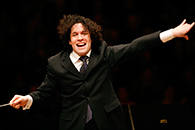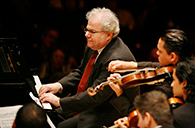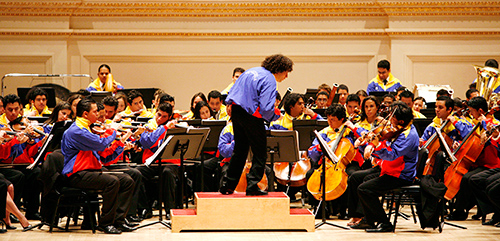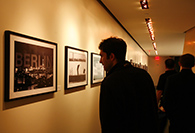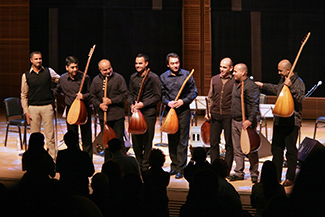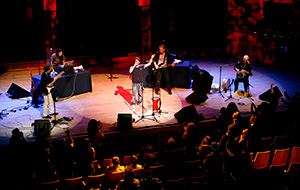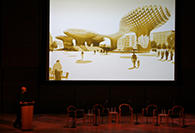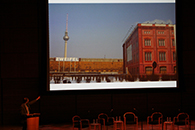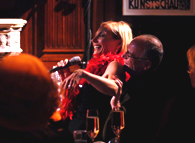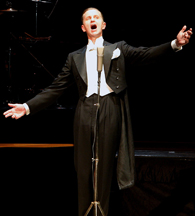
The Berlin in Lights Festival Blog

Noah Block-Harley is a graduate of Columbia University, where he recently earned a degree in Comparative Literature and German after four years of solid effort. While he ultimately plans on moving to Berlin to pursue arts journalism, he currently resides in the single greatest neighborhood in New York City: Astoria, Queens.

A recent graduate of Northwestern University, Nick Romeo is a published fiction writer and an avid amateur pianist. He worked on the editorial staff of Carnegie Hall last year and is thrilled to be covering the Berlin in Lights festival. Nick lives in Manhattan and is working on a first novel.

Kris Wilton has written about arts and culture for such publications as Entertainment Weekly, ARTnews, and the Village Voice and is currently associate editor of artinfo.com. She lived and worked in Berlin for several years and would give most anything to meet Pina Bausch, with whom she shares a birthday.
Stay up to date with the latest from our three festival bloggers as they experience the Berlin in Lights festival firsthand—subscribe to the blog’s free RSS feed.
Tschüssi, Berlin in Lights!
11/19/2007 2:02 PM
Posted by Kris Wilton
Aaahhh … Two-plus weeks of Berlin-in-New York cultural bliss are over. Whatever will we do with ourselves now, without Daniel Libeskind and Franz Biberkopf and good ol' Flo Henckel von Donnersmarck to keep us busy?
I of course can't speak to everything that the festival had to offer, but from what I saw, I think there were just a few events that were disappointing-like that architecture non-panel (!)-and just a few things missing.
I would have liked to have see, for example, some dance-imagine seeing Sasha Waltz in New York! (Sadly my idol Pina Bausch, the very best thing European dance has to offer, wouldn’t have fit into the Berlin theme anyway, being based in Wüppertal.) And it would have been great to have more younger, German-born artists included: a reading or two by writers based in Berlin, for example, perhaps in dialogue with American or other non-German artists living there.
I feel extremely lucky to have seen and covered all I did, though, in particular the mind-blowing Simón Bolívar Youth Orchestra, the film offerings at MoMA (the Kino! series is a particular pleasure for me every year), the Talents II: New Photography from Berlin exhibition at the Goethe-Institut, and the screening with live music of Berlin: Symphony of a City. And there are several offerings I still have to check out, like the exhibition of Roland Horn photos of the building of Berlin’s Hauptbahnhof at the German Consulate.
One disappointment of the festival perhaps was that it didn’t draw more of a younger crowd. I did spot good showings of young folks at Talents II, and the opening of the Berlin—New York Dialogues: Building in Context exhibition at the Center for Architecture was one of the most rockin’ exhibition openings I’ve ever been to in New York, seriously-complete with appearances by the German pop duo Zweiraumwohnung, who DJed, and the actress Julianne Moore, who just seemed to be have a great time. But at a lot of the film screenings and panel discussions and readings I’m sure I lowered the mean age by at least a couple of decades. Young New York culturati, where were you?
All in all, I think the festival achieved what it set out to do: offer a sense of what Berlin is about through its music, architecture, cinema, literature, art, politics, and culture at large. I know I learned a lot, and I can't wait to get back over there to see the city with new eyes.
Stravinsky for All
11/19/2007 1:55 PM
Posted by Nick Romeo
The crowd at the United Palace Theater on Sunday afternoon was probably one of the most diverse groups that a Carnegie Hall event has attracted for quite a while. There were Harlem locals and Carnegie Hall regulars; there were babies and grandparents and every age in between; there was even the Mayor of Berlin, who flew to New York to see the last three events in Carnegie Hall’s groundbreaking Berlin in Lights festival. The occasion on Sunday was the Rite of Spring Project, an endeavor that united the Berliner Philharmoniker with children from New York City public schools for a performance of Stravinsky’s seminal 1913 masterpiece.
The United Palace Theater was a magnificent venue for the performance. Not only is the theater a marvel of gold and rococo architecture, it’s also capable of accommodating an entire symphony orchestra and a dance corps of almost 100 students.
The afternoon began with a performance of an original composition by 81 high school students who worked with musicians from the Berliner Philharmoniker to produce a work inspired by the Rite of Spring. Any work conceived by over 80 students is bound to be a bit eclectic, and this composition was no exception. The work was scored for voice and percussion, and while some of its rhythms and melodies loosely alluded to the Rite of Spring, most of the work was largely unrelated to Stravinsky. There were episodes of chanting, spoken-word poetry, hip hop rhythms, choral passages, and purely percussive interludes. The lyrics to the choral sections were ostensibly addressing the themes of rites and sacrifices, and while some of them did engage these topics, many of the lyrics were about street gangs and the importance of resisting peer pressure. But if the goal of the project was to encourage the kids to integrate their own experiences into a musical composition, it succeeded.
The second half of the concert was a performance of The Rite of Spring by Sir Simon Rattle and the Berliner Philharmoniker. Ninety-four public school students ranging in age from second to twelfth grade danced to the music in a piece conceived by British choreographer Royston Maldoom. The movements of the dancers were loosely narrative. There were suggestions of war and conflict, ritual and sacrifice. There was also lots of arm movement, jumping, running, and general writhing. One of my favorite moments was when a mob of small dancers hoisted an older dancer into the air and carried him partway across the stage; it was impossible not to think of Gulliver among the Lilliputians. Another charming moment, though less choreographed, came when one of the youngest dancers waved to the audience from the stage. A few minutes later the same dancer had an endearingly difficult time climbing onto the back of an older dancer. The overall visual effect was varied and colorful, with the dancers dressed in red, green, and orange outfits. The Berliner Philharmoniker played the savage rhythms and revolutionary harmonies of Stravinsky’s score with visceral intensity and perfect precision.
A fairly relaxed etiquette prevailed at the event. Not only did cell phones ring throughout the concert, but people sometimes answered them and had conversations. Babies cried and kids played in the aisles. And while this dismayed certain patrons, it also seemed a relatively small price to pay for the increased exposure to classical music that such concerts provide.
Barock and Roll
11/19/2007 12:34 PM
Posted by Noah Block-Harley
In his essay “Tradition and the Individual Talent,” T. S. Eliot notes that “no poet, no artist of any art, has his complete meaning alone. His significance, his appreciation is the appreciation of his relation to the dead poets and artists. You cannot value him alone; you must set him, for contrast and comparison, among the dead.” While Eliot was writing about the creative process itself, the same argument applies to performances, readings, or stagings of others’ work. In a way this relationship becomes even more important; for music, one not only engages with the composer’s original score in performing a well-known piece, but also with the history of that score’s performance, with heretical interpretations, “standard” renditions, and so on. It is precisely because the tradition of interpretation is so important (if only because it is inescapable) that I was nervous about last night’s concert by the Berliner Barock Solisten. At its worst, historically informed performance (or its wildly misleading acronym HIP) looks to circumvent the time elapsed between a piece’s composition and its performance, missing out completely on the possibly influential but certainly informative interim. And it certainly seemed to be heading that way at the outset, with one member sitting down to an ornate harpsichord and another brandishing the fantastically bizarre looking theorbo. Then they began to play.
Each member moves differently according to the instrument he or she is playing; the violins become kites which hover over the melody before plunging into the thick of it, fiery nosedives that are saved from certain destruction only by the ascending trudge of the bass. The harpsichordist pecks at his instrument, leaping excitedly from his seat every so often, while the cello—that most melancholy of instruments—breathes in sharply, pained at the thought of continuing. While these acrobatics would already be an impressive showing on their own, they also play perfect counterparts to the ensemble’s musical program, which is no less impressive. Featuring works by Handel, Corelli, Vivaldi, and Bach (among others), it is a repertoire that the Solisten are skilled enough to play and smart enough not to get in the way of. Whether it is a short, relatively simply sonata by Pisendel or a longer, more involved call-and-response concerto for the reedy oboe d’amore by Handel, the group featured the uncanny ability to place their own emphases or facial expressions (the latter owing in no small part, as Nick Romeo has noted, to their aristocratic eyebrows) at just the right moments, and to let the music speak for itself for the rest of the time.
Albrecht Mayer, the ensemble’s upstart oboe player, is the best example of this talent. Dressed in a black, crushed velvet jacket with red cuffs and tight black pants, Mayer was dressed to play (and played well) the part of the virtuoso, prancing about the stage like a Baroque pied piper. He sparred more than once with Rainer Kussmaul (violin), the director of the ensemble and principal concertmaster of the Berliner Philharmoniker from 1993 to 1998, the latter countering Mayer’s trills and runs with his own quick, firm playing. “Very few know when there is expression of significant emotion,” Eliot writes at the end of his essay, “emotion which has its life in the poem and not in the history of the poet. The emotion of art is impersonal. And the poet cannot reach this impersonality without surrendering himself wholly to the work to be done.” Baroque chamber music is a highly formalized affair that demands a high level of technical expertise to play and an even greater love for the music to really perform. It is to the ensemble’s credit that they were able not only to play all of the notes, but also suggest the intentions and inspirations behind the music itself.
Perfectly Invisible
11/18/2007 1:53 PM
Posted by Nick Romeo
The best performers are often the least conspicuous. Rather than displaying their brilliance for its own sake, they use their musical intelligence to achieve the higher goal of illuminating the music. They seek to direct attention away from themselves and toward the music, sometimes to a radical extent. The great pianist Glenn Gould went so far as to renounce live performance for many years because he wanted his audience to focus entirely on the music. Though the members of the Philharmonia Quartett Berlin, all drawn from the Berliner Philharmoniker, still give live performances, they also place an emphasis not on their performance but on the music it is recreating.
They began their Saturday evening concert at Weill Recital Hall with Mendelssohn’s String Quartet No. 2 in A Minor. Written when he was 18, the quartet gushes with adolescent yearning and volatility; it sounds a bit like what happens when you mix teenage angst with musical genius. The Romanticism of the first movement gives way to a fugue in the slow movement, but the strict counterpoint dissolves back into the flow of longing chords and suspensions. The quartet’s playing was excellent to the point of perfect transparency, as if you could look through the performance into the music.
They followed the Mendelssohn with Webern’s Five Pieces. Just as Mendelssohn’s Romantic quartet contains Baroque gestures, Webern’s modern atonality still shows traces of Romanticism. Certain languorous phrases evoked the lost world of Brahms and Mendelssohn, but they quickly gave way to the eerie dissonance and extreme concision of Webern. Though the piece is hardly programmatic, its sounds seemed to conjure the decay of an abandoned mansion, its sighs and creaks under centuries of dust.
The second half began with György Kurtág’s 12 Microludes for String Quartet. The quartet shares the miniaturist aesthetic of Webern, but despite its condensed scale there is still an extraordinary range of moods in the music. The musicians captured the rapidly shifting qualities of the piece—from serene to snarling in a few measures—with drastic dynamic contrasts that were often comically sudden and unexpected.
They closed the program with a quintessential Romantic quartet by Robert Schumann and returned to play the slow movement from Schubert’s “Rosamunde” Quartet as an encore. The irony of such perfect performances is that while they may focus our attention directly on the music, they are also so rare that the musicians win great renown and acclaim. Only through perfect inconspicuousness do they ensure their lasting fame.
Of Speakeasies, Radio Plays, and Rather Long Readings
11/18/2007 10:52 AM
Posted by Kris Wilton
Saturday’s Berlin Alexanderplatz reading at the Goethe-Institut felt like something from the long-gone era of speakeasies and radio plays.
I didn’t know before I arrived that the reading was four hours long, which is really quite long for a reading. The event was blocked out for 2 to 6 PM, with nine different readers, each scheduled for 20-minute blocks, some twice.
Juliane Wanckel, who planned the event, told me she’d originally conceived a marathon reading of the entire book, as is often done with James Joyce’s Ulysses, but she wasn’t sure that Alfred Döblin, the book’s author, has as much of a following.
The advantage of a reading like that, which would take at least 12 hours I guess, is that people would come and go as they please. But still, although some listeners certainly snuck out of this reading early (including, disappointingly, several performers who left just after their turns), there was a good-size crowd of about 25 or so left at the end.
The performers included the actors Erin Beirnard, Jeffrey Essmann, Michael Hardart, Kathrin Kana, Anna Kohler, and George Spaeth plus the musician-performer Cassis and the German novelist and screenwriter Pia Frankenburg, who were extremely entertaining. Wanckel said she’d carefully selected the passages to include all the major events of the book, important stylistic elements such as interior monologues, and significant passages about Berlin. She designated two readings in German so that the audience could get a sense of the original language and hear the Berlin dialect, which Frankenburg, a native Kölnerin, performed with aplomb.
The afternoon was kicked off with a short intro by Goethe-Institute program director Stephan Wackwitz and a reading by Alfred P. Doblin, the author’s grandson, a newspaper editor in New Jersey who appears to have dropped the umlaut in the name. He read one passage from the book and another from his grandfather’s memoir, Destiny’s Journey, both about Berlin. The first presented a gay and vibrant place; the second described the city in 1947, when Döblin returned for the first time after the war. It shows rubble and destruction, friends dead and soldiers roaming the streets, people either selling their possessions to survive or “playing at postwar life.” These passages were simply read, not performed, but there was something poignant about seeing the war-era writer’s prosperous American kin reading his work for an audience of enthusiastic fans in New York in 2007.
The event, like many in the festival, could not have happened without its organizer, in this case Wanckel. The native Berlinerin, who was also involved with organizing the Kino! Berlin series at MoMA, was positively thrilled to present the book, which she told me she first read and fell in love with as a 14-year-old in divided Berlin. She said as she went through the book she would ask her grandmother, born around the turn of the century, about the cafés and restaurants and theaters and streets, especially those then in East Berlin, which she had never seen.
Extreme Music
11/17/2007 10:09 AM
Posted by Noah Block-Harley
The Berliner Philharmoniker easily qualifies as one of the most highly regarded orchestras around, a reputation that extends back to its founding in 1882. This will not be news to most, but it bears repeating here for a couple of reasons. First, the position that the orchestra occupies and has occupied at the epicenter of the classical music world means that its audiences do not come to concerts without specific and demanding expectations. As with many important acts, it is often as not the sheer fact that the Philharmonic is playing that draws attention as much as the actual program it intends to present. Second, the orchestra’s historical importance to classical music, paired with its close relationship to the city of Berlin—one could approach the modern history of Berlin through the different concert halls in which the Philharmonic has played—both saddles and blesses the orchestra with a tremendous amount of political and artistic baggage. It is not only the current Philharmonic that shows up at any given concert, but also the sum total of that institution’s history; from the astounding number of compositions premiered with the orchestra to the seemingly interminable list of classical luminaries who have played with or conducted for the orchestra.
It is this history, moreover, with which the Philharmonic is actively engaging, an effort visible in both the program and performance of last night. The orchestra’s weeklong residency at Carnegie Hall—a residency around which the entire Berlin in Lights festival was originally conceived and planned—occurs within a yearlong series of performances, lectures, and festivals in honor of the orchestra’s 125th anniversary. Many performances, including a modified version of the Mahler performances in Berlin not three weeks ago, have attempted to set into dialogue the music of the early 20th century with that of contemporary composers.
Last night was no exception. The first part of the performance consisted of György Kurtág’s Stele, a shorter piece composed in 1994 during the composer’s two-year residency at the Philharmonic itself. The performance was remarkable; Rattle exhibited a restraint that he was later to abandon for Mahler’s Tenth, allowing Kurtág’s haunting score to develop on its own terms. It is a piece of extremes, pairing shrill violins with the deep and haunting echo of drums. The ebb and flow of the strings—in much of the piece consisted—complemented beautifully the perpetual threat of the brass and timpani. The Philharmonic’s decision to program Kurtág’s piece only became clear, however, in the second half of the performance, with Mahler’s Tenth. The close affinity the two pieces share is perhaps most apparent in the percussion; at one point during the symphony a drum sounds repeatedly from offstage. It is then that the listener is reminded forcefully of Kurtág’s own orchestration, which employs the timpani to similar dramatic effect. Rattle was astounding throughout the evening, although he had apparently (and rightly) saved his energy for Mahler’s unfinished behemoth. Both impassioned and precise, direct without being overbearing, he struck a delicate yet inspiring balance between conjuring notes out of thin air and recoiling from the full force of the orchestra’s 100-plus members. I was reminded of the sorcerer’s apprentice.
The Philharmonic’s performance of Mahler’s Tenth held the audience rapt for 77 long minutes. It is perhaps the best compliment I can pay to the orchestra when I note that they not only reminded the audience of the reasons for their reputation, but inspired confidence on new grounds. For it was not only the universe Mahler succeeds in creating (or beginning to create) in his Tenth Symphony that was on display last night. It was also the “free orchestral republic,” as the conductor Wilhelm Furtwängler once described the Philharmonic, which was a world unto itself.
Raised Eyebrows
11/16/2007 1:48 PM
Posted by Nick Romeo
The eyebrows of many chamber musicians are impressive instruments in their own right. They seem to have trained for years in the best European conservatories to achieve their sizable repertoires of arches, creases, furrows, and crinkles that register the shifting qualities of music with such magic mobility. The musicians of the Scharoun Ensemble Berlin were fairly restrained in comparison to the facial performances you see in some groups, but they too had their share of eyebrow moments at Thursday night’s concert in Zankel Hall.
The sheer gorgeousness of the first piece on the program, Schubert’s Notturno in E-flat Major for piano trio, made this somewhat inevitable. The moments often came just before particularly beautiful points in the music; as a harmonic climax or resolution approached, they would raise their eyebrows in anticipation, as if to say: this next chord is going to be divine. And while this can seem a touch indulgent in some musicians, facial expressions serve an important communicative function in a good ensemble—they allow the musicians to gauge one another’s reactions and coordinate their interpretations.
British pianist and composer Thomas Adès joined Scharoun Ensemble members Chrisoph Sreuli and Nicolas Altstaedt on the first trio. While the three may not have played together long enough to acquire the instinctive familiarity with each other’s playing that can make certain trios sound governed by a single collective intelligence, they were nevertheless quite expressive and sensitive to ensemble unity. The result was a pleasurable performance distinguished by clear delineation of melodies and subtle dynamic shifts as themes repeated and intensified.
The next piece was a piano quintet by Mr. Adès. Though more harmonically complex than the Schubert, the piece was neoclassical in some ways. The development of the opening motive and its movement between instruments was reminiscent of a classical quintet. But while the structure was a rough A-B-A-B, the harmonic framework reminded me a bit of Bartók or Shostakovich. Certain recurring passages had a thrilling rhythmic intensity that also recalled Bartók. Adès proved a very capable pianist, and the quartet followed his gestures and cues in their interpretation of this interesting new work.
The evening ended with Schubert’s Octet in F Major. This six-movement piece gives the double bass, the horn, and the bassoon a chance to play the chamber literature from which they’re often excluded. The piece contains a great variety of styles, ranging from buoyant theme and variation movements to a mournful, beautiful adagio. The ensemble played the passages of embellishments and Viennese charm with great precision and zest. They also gave an exquisite performance of the beautiful adagio, though it seemed unfortunate that the horn player decided to empty the spit from his mouthpiece during this sublime movement. But soon he gave his eyebrows an expressive wrinkle, and all was forgiven.
On the Corner of Friedrichstraße and Delancy
11/16/2007 8:59 AM
Posted by Noah Block-Harley
It may have been the children pummeling the timpani after the performance. Perhaps the group of elderly Polish women chattering excitedly before. Whatever it was, if Carnegie Hall sought last night to bring its program not only to a venue distinct from Carnegie Hall itself, but to a neighborhood spot, it certainly succeeded. Stravinsky’s musical fable L’histoire du Soldat (A Soldier’s Tale), written in 1918, is a short (45-minute) piece composed for a seven-member ensemble modeled after the Dixieland Jazz bands of old, and comprising a happy mixture of traditional melodies, martial rhythms, and the occasional clarinet squawk. Each of these musical components is in turn worked into the (somewhat disturbing) story of a soldier who vies over a number of years with the Devil for his “violin,” or soul. While Stravinsky’s hand is clearly at work throughout the piece, the music itself—at least as it was presented last night—serves more as accompaniment to the story than as an actual focal point. It is appropriate, moreover, that the ensemble should have privileged the story for a neighborhood concert; it was a combination of the composition and the performance that held the audience’s attention for the duration of the piece, no small feat considering the number of potential tantrums in the room. The small gathering of children, grandparents, and parents, and the equally small group of the classical crowd all huddled around the small cast of players—who for their part seemed to be enjoying themselves immensely—almost as a town would around itinerant musicians. In a sense, this was exactly what was happening, albeit on a much, much larger scale.
It was not only the audience that was enthusiastic about both the performance of and idea behind the concert, however. In a brief conversation with the bass player for the ensemble—made up of members of the Berliner Philharmoniker—it was clear that the orchestra itself is tremendously excited at the chance to play outside of Manhattan, and in venues not specifically built for classical concerts. A member of Carnegie’s team noted that one particularly enthusiastic orchestra musician had played in four different concerts throughout the city. It seems fitting that a festival about Berlin should occur in so many places, that the Philharmoniker should be running all over town, playing in police academies, community centers, and churches. In a certain sense it is the best way to approximate the sprawling nature of Berlin’s landscape (geographic and otherwise), and certainly the best way to introduce New York, on its own terms, to a staple of Berlin’s cultural diet.
Berlin in Lights is almost over! For those of you who have yet to go to anything (woe betide thee), I emphatically, ecstatically recommend The Rite of Spring project, this Saturday and Sunday at the United Palace Theater in Washington Heights. From what I have heard, it promises to be quite a sight …
An Abundance of Shadows
11/15/2007 2:26 PM
Posted by Nick Romeo
The P.S. 1 Contemporary Art Center has perfected the art of stylish dilapidation. The walls are scuffed, the white paint in the stairwells is peeling, the red bricks are chipped and exposed. The Queens branch of the Museum of Modern Art, P.S. 1 was a three-story schoolhouse long before its conversion into a museum in 1971. Whatever else the transformation involved, many of the physical signs of age and abandonment were preserved. It’s an irony worthy of the museum that the institutional neglect that haunts so many public schools has in one instance been cherished and cultivated as an entire aesthetic of disrepair.
The current exhibit of the massive 1980 film Berlin Alexanderplatz by German director Rainer Werner Fassbinder is well suited to P.S 1 in two ways; not only does Fassbinder’s film share the museum’s aesthetic of grunge and shadow, it’s also a form-expanding and provocative work of relatively contemporary art. Fassbinder’s nearly 16-hour film is being shown through January 7 on the third floor of the museum. One can view the exhibit in several ways; the complete work runs on a permanent loop in a large room, but the film is also mercifully divided into 13 episodes and an epilogue that play in small black theatres that seat two. There are also iconic still images from the movie, photos from its shooting, and copies of Fassbinder’s annotations of pages from the 1929 Alfred Döblin novel that inspired him.
Given that the museum does not stay open long enough for a visitor to see the complete film in one or even two visits, it’s necessary to dip in and out of scenes to a certain extent, as if browsing through a book. But the film is so darkly engrossing that it’s easy to sit through three of four complete episodes in an afternoon. The darkness of the film’s vision is nicely expressed by a sequence in the first episode in which the hero, Franz Biberkopf, rapes the sister of the woman he was sent to jail for beating to death. After the rape, an exultant Franz says “I’m so happy, I’m a human being again!”
The darkness is present not only in the actions but also in the lighting of the shots. The early sections of the film proliferate with an abundance of shadows; faces and bodies are bathed in a dim half-light and rooms are webbed in shadow and obscurity, as if the darkness were seeping from the surroundings into the characters.
The film’s setting is Berlin between the wars, and its specific focus is the demimonde of Berlin, its dissolute and drifters and whores. The story loosely follows Franz through bouts of violence, drinking, and unemployment as he voyages through back streets and bars. A detached narrative voiceover sometimes comments on the action as it unfolds; perhaps the most chilling instance of this is a scene in which we watch Franz beat a girl to death while the narrator gives a dry lecture on the physics of her death, citing Newton’s laws and explaining force and resistance. As the lecture continues, a set of equations appears on the screen, tempting you to reduce the meaning of the murder to an exemplum of a law of physics.
The film has more hopeful moments, but the gruesome epilogue, in which humans are gutted and trussed in a slaughterhouse while Wagner blasts, is the most horrific expression of the grim historical foreboding that haunts the film throughout.
Fun and Mourning with Adès and Mahler
11/15/2007 8:59 AM
Posted by Kris Wilton
Last night’s Berliner Philharmoniker performance at Carnegie Hall was rather a somber affair, particularly in contrast to the Simón Bolívar Youth Orchestra on Monday. The crowd was much less chic also, but it did include American Academy in Berlin director Gary Smith, who I’m perversely proud to say I’ve been tracking around town like he’s Jake Gyllenhaal or something.
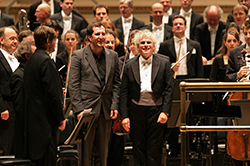
Composer Thomas Adès with Sir Simon Rattle and The Berliner Philharmoniker
© 2007, Chris Lee
The evening began with the US premiere of wunderkind composer-conductor-pianist Thomas Adès’s Tevót, a work jointly commissioned by the Philharmoniker and Carnegie Hall.
In a pre-performance talk, Adès, a dry, funny guy with a voice like Alan Rickman’s, said that he hadn’t listened to the work since its premiere last February in Berlin. “It’s not the kind of work you just stick on the player and listen to while you’re washing up,” he said. “It’s quite intense.” The sound of it at the morning rehearsal was “a shock,” he said. “I hear it as a piece almost by some other person now.”
I know this feeling. It happens to me from time to time, and fiction writers in particular describe it a lot: reading something that you know you wrote but cannot imagine having written. Listening to Tevót, I wondered what it would be like to hear this strange and squeaky and mournful work, and know that I had created it.
Tevót is a Hebrew word for vessels, Adès said, or for arks, like in the bible, or for bars of music, which he pointed out are also vessels of sorts. He said he’d intended for the piece to depict “a journey on the biggest possible scale.”
He also said he wanted it to be like “falling through space or water.” This rang truest to me. The piece begins with dreamy, tentative, squeaky violins pushed to the top of their range. I can’t say it ever resolves into more comfortable sounds, but there are moments of real beauty among the passages of trepidation and lament that make up the remainder of the 22-minute work. And the ending, which Adès said took even him by surprise when he wrote it, is in fact unexpected, and lovely, so I won’t give it away.
To follow this, Carnegie programmed Das Lied von der Erde, because really, who lightens up an evening like Mahler?
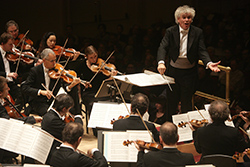
Sir Simon Rattle and The Berliner Philharmoniker
© 2007, Chris Lee
Considered the then-ailing composer’s prolonged farewell, Das Lied takes as its texts several Chinese poems (though German translations of French translations, so who knows how faithful they are?). The work is divided into six movements: three ostensibly cheery ones sung by a tenor and three dour, melancholy ones by a baritone or sometimes a mezzo-soprano.
Personally, I prefer the dour ones, performed tonight by Thomas Quasthoff, whose big, rich bass-baritone truly is shocking taken in combination with his small stature. These are simply beautiful, with often spare orchestration heavy on woodwinds and sad, mournful melodies. I particularly love “Der Einsame im Herbst,” which the program calls “The Solitary in Autumn” but I would translate as “The Lonely Guy in Fall,” which evokes a pleasing earthiness with lots of oboe and cello. If it were a wine it would be a pinot noir.
The movements sung by the hulking and extremely serious Ben Heppner were the most fun, though. Of the three, two were about getting drunk, and feature such lines as, in part V, “The Drunkard in Springtime,” what I’d translate as, “Who cares about spring? I want to get drunk!” Except, in Mahlerese, with the tenor booming above a full orchestra, it’s more like, “I WILL GET DRUNK! IT IS SPRING!”
All in all, the evening was great, and the audience seemed pleased. There was a standing ovation at the end, and Rattle and Heppner and Quasthoff came out several times. Quasthoff in particular beamed delightedly, as rightly he should. He was fantastic.
iTunes Downloads
11/14/2007 7:28 PM
Be among the first to download a new recording of Mahler’s 9th Symphony by Sir Simon Rattle and the Berliner Philharmoniker.
Download Now ›
Please note that this link will launch iTunes. Get iTunes.
Very Full of Sounds
11/14/2007 1:51 PM
Posted by Nick Romeo
It’s far too easy to dismiss a composition you don’t immediately understand as incomprehensible rubbish. The small leap from “I don’t understand” to “There’s nothing to be understood” was the force behind the famous scorn of the audience at the Paris premiere of Stravinsky’s Rite of Spring. Though they inspired no riots, Beethoven’s late string quartets were also met with general puzzlement and indifference. Of course not every piece that audiences dislike is destined to become a canonical masterwork; whether liked or not, only a small percentage of music enjoys a life longer than its composer’s. Yet our consciousness of how rejected works can rise from disgrace makes us aware that any criticism is subject to reversal.
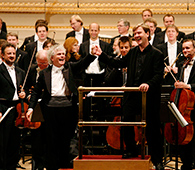
Composer Magnus Lindberg with Sir Simon Rattle and The Berliner Philharmoniker
© 2007, Jennifer Taylor
The US premiere of a new work by Finnish composer Magnus Lindberg at Carnegie Hall on Tuesday night met with a mixed reaction. There was polite applause when the composer joined conductor Simon Rattle and The Berliner Philharmoniker on the stage after the piece’s conclusion, but audience comments during intermission were somewhat tepid. Anticipating the performance of Mahler’s Ninth Symphony after intermission, one man remarked, “Now for some real music!” Others were less harsh; the woman beside me captured the strength of the music wonderfully when she remarked with genuine enthusiasm, “It was very full of sounds.” The piece did indeed create a rich acoustic texture, and its often unexpected juxtapositions of sounds showed an interest in the possibilities of orchestration. The shifting and unstable tonalities and tempos also evoked a sense of deep unease. Simon Rattle and the Berliner Philharmoniker were as flawless as their reputation promised, and the first cellist played a particularly impressive solo with intense power.
The second half of the program was devoted to Mahler’s radiantly beautiful Ninth Symphony. The expanded scale of a 75-minute symphony makes demands of audience and musicians alike. Mr. Rattle displayed a marvelous ability to grasp the vast structure of the symphony; he was able to capture, for instance, the way the meaning of a musical phrase can be transfigured by the music that intervenes between its first appearance and its later return. In the first movement, the eventual return of the infinitely gentle first melody was made all the sweeter by the minor anguish and tumult that precede it. Rattle was sensitive to such nuances of phrase and structure, and the orchestra’s dynamics and balance were often so perfectly calibrated that the music felt newly clarified, its secrets elucidated by the power of their performance.
The demands made of the audience are not only adjusting to the large scale of the work and following its journey through keys and moods. There is also the simple demand that the audience must remain silent. Mr. Rattle made this explicit when he addressed the audience after the first movement and said, “This is music created from silence and returning to it, please help us create this magic.”
His request was honored for the rest of the symphony, and the famous final progression toward silence unfolded with the rapt focus it deserves. The loss evoked in the final bars of this beautiful conclusion was made all the more moving by the range and scale of the preceding movements. It truly felt as if all things were coming to an end. Yet as I left the hall, I thought of the beginning of the symphony and the way its longing depends on a lack of resolution, a poignant hovering on the ninth of a D-major chord. Death had sent me back to life in all its unresolved glory.
Angels and Tangos
11/13/2007 1:27 PM
Posted by Nick Romeo
If music is any indication, angels differ rather widely by nationality. The first half of the program the 12 Cellists of the Berliner Philharmoniker performed at Zankel Hall on Monday night was titled “Angel Dances.” The angels found in Piazzolla’s three tangos—the dance, death, and resurrection of the angel—were tinged by the Argentine melodrama and rhythmic genius of their composer’s sensibility. And the hints of angels in Debussy’s “Sunken Cathedral,” Mendelssohn’s Elijah, and Verdi’s “Ave Maria” were inflected with suspiciously French, German, and Italian styles. But the cellists moved among styles and periods with ease and wit, capturing the pulpy romance of Piazzolla’s melodies in one song and the classical clarity of Verdi’s inner lines in the next.
The highlight of the first half was Debussy’s haunting prelude “The Sunken Cathedral.” The name is evocative enough in English, but the French—La cathédrale engloutie—is even more beautiful. Debussy’s title seems to make architectural metaphor inevitable, and the music conjures a cathedral’s arches with ascending seconds and fourths. The power of the piece stems not only from its music, but also from the way the title washes the mind in images of submersion and grandeur; it’s easy to hear the rustlings of dark sea ferns against pews and icons in the suggestive harmonies of the score.
Listening to a concert by the cello section of an orchestra might seem a bit like watching a dance recital by a ballerina’s left leg. Severed from its larger context, is just a section of a great ensemble still viable? In the case of the cellists of the Berliner Philharmoniker, the answer was a resounding yes. The 12 cellists had a stunning range of effects. They did virtuoso passage work and lyrical melody; they plucked and strummed, glided and caressed, often within the same song. In one piece by Kaiser-Lindemann they passed a pizzicato arpeggio around the semi-circle as if it were a bottle of whiskey and each note a swig.
The second half of the program was titled “Dances of the World,” and the earthly delights of Gershwin, Shostakovich, and Piazzolla more than compensated for the departure of the early angels. The audience seemed genuinely delighted by each of the selections, and the cellists were obviously enjoying themselves as well. After a standing ovation, they offered a virtuostic Piazzolla tango as an encore. When the audience clamored for a second encore, they returned to finish the night with the sly goofiness of the theme song from “The Pink Panther.” It was a perfect closing touch to a beautiful evening.
Like Nothing I’ve Ever Seen Before
11/13/2007 10:10 AM
Posted by Kris Wilton
Oh boy oh boy oh boy, I had no idea what I was getting into with the Simón Bolívar Youth Symphony Orchestra. I have honestly never seen anything like it.
The orchestra is 200 young musicians between the ages of 16 and 20, culled from the 130 orchestras across Venezuela that make up the “youth” division of the country’s pioneering national music education system, founded in 1975 and commonly called el sistema. It’s appearing in the Berlin in Lights festival because of its long-running partnership with the Berliner Philharmoniker.
But they sure don’t play like kids, I’ll tell you that. The orchestra, conducted by the infectious 26-year-old alum and rising star Gustavo Dudamel, who will take over as music director for the L.A. Philharmonic in 2009, started with Béla Bartók’s Concerto for Orchestra, whose commission was, according to the program notes, “a tonic for the ailing composer,” who was sick with leukemia when he wrote it. The 36-minute work ranges from gentle melodies to low, beehivey rumbles to ebullient passages that feel like someone trying to express all the exuberance of life at once; it had the strings, especially the violins, just about bouncing out of their seats. They play violin like Tori Amos plays piano. It ended with what sounded like two friends greeting each other after a long time apart, and then four friends, and then eight, and then the whole world warmly chattering away. And I thought, what a gift to see these energetic young people playing this particular piece.
The members of the audience—the regular symphony-going crowd, plus a healthy dose of Latin Americans—leapt to their feet, screaming bravo and bravi, and they stood there cheering until Dudamel had come and gone three times, and had singled out soloists and then entire sections of the orchestra, and I had cried. Yes, cried. It was that kind of performance.
After the intermission came Shostakovich’s Symphony No. 10 in E Minor conducted by Simon Rattle. This piece was weightier, more dour—Shostakovich wrote it after Stalin’s death in 1953, and it’s commonly believed to be his reaction against the oppressive regime. It sounds it. There are heavy plodding bass lines and lots of heralding trumpets and crashing cymbals. But it also ranges all the way to the most delicate of string lines, played so tenderly and perfectly in unison that I’m sure the whole auditorium was holding its breath.
And at the end, there’s a lovely triumphant section in which the orchestra seemed to be bouncing one melody around from section to section, as in conversation, with each group contributing its own tone or tenor. A celebration of free thinking, creativity, and collaboration, it was a perfect end to the evening.
But no. Again the audience sprang up, and again the conductor—this time Rattle—came and went several times and singled out soloists and sections (though this time I didn’t cry).
Then, after some discussion among the orchestra, Rattle had the audience sit down, and he announced they would play an encore. An encore! And then the orchestra, all prim and proper in their black concert wear, launched into the mambo from Bernstein’s West Side Story. I’m not kidding. There were splashy cymbals and swinging horns, and then the cellos were spinning around on their pins and violins and violas were turning in the air and then the string sections stood up and danced. Yes, danced. The audience was incredulous and ecstatic and Dudamel grinned down from the first balcony, his shirt untucked and his cuff links gone.
And then there was another ovation, and again Rattle came and went, until finally the musicians all held their instruments high in the air—the bassoons standing tallest—and then they shuffled out. And still people were cheering.
The performance was captured by channel Thirteen for the public television series Great Performances. Catch it Monday, January 7, 2008, at 9 PM on Thirteen. Coverage of the festival will also be included on New York Voices on Tuesday November 20 and 27 at 10:30 PM.
Politics as Usual and Then Some
11/12/2007 2:08 PM
Posted by Nick Romeo
At Sunday evening’s Political Berlin panel discussion at Weill Recital Hall, there was much talk of “key issues” and “steps forward” and “vital partnerships” and “cultivating the transatlantic relationship.” Though I enjoyed the suggestion of amorous intrigue in this last phrase, the rest of the language was often opaque and vague. Though the fact that a panel composed of former and current diplomats, politicians, and ambassadors would display a talent for evasive prolixity was not exactly a shock.
What was rather surprising was the lucidity and clarity of the comments of former Secretary of State Henry Kissinger. One might expect that his statements would conform to the verbose emptiness so common among politicians. Yet Kissinger was able to deliver sharp verdicts and opinions in clear language. Asked whether the European and global distaste for American power had causes deeper than the current President, Kissinger remarked, “We judge other countries by the degree to which they agree to propositions that we formulate without their cooperation.” Not only was the comment intelligible, it seemed to question the assumption of the other American panelists that American power was consistently deployed in appropriate ways.
Throughout the evening, the panelists spoke not of countries and continents but of issues and problems: the issue of Afghanistan, the problem of Iran, the problem of Asia. I couldn’t help wondering: a problem to whom, and from whose perspective? Do the people of Iran consider themselves a problem? But such questions were never addressed by the panelists, who tended to divide the world into American interests and “problems” that posed threats to those interests. Explicitly stating the nature of those American interests would have been helpful and revealing.
After the talk, one audience member asked why the United States blocked Germany’s quest to gain a seat on the Permanent Security Council of the United Nations. The answer was unexpectedly blunt. Panelists Joe Joffe and John Kornblum agreed that the move was fitting retribution for Germany’s failure to support the US invasion of Iraq. In Joffe’s words, it was “payback time.” To hear such vindictiveness was discouraging, though perhaps unsurprising, given that Joffe also remarked that “it ill behooves one to sit here and cast aspersions on the President of the United States.”
The panel recalled the relevance of George Orwell’s classic essay “Politics and the English Language.” Writing of the degradation of language and its consequences for a country, Orwell reminds us of the following: “Modern English, especially written English, is full of bad habits which spread by imitation and which can be avoided if one is willing to take the necessary trouble. If one gets rid of these habits one can think more clearly, and to think clearly is a necessary first step toward political regeneration …” Whatever your political ideas, it’s hard not to agree that the ability to express them precisely and explicitly is the first step toward meaningful conversation.
The Venezuelan Invasion
11/12/2007 7:38 AM
Posted by Nick Romeo
What a Venezuelan youth orchestra has to do with a Berlin cultural festival seems difficult to establish until you embrace the obvious answer: not much. But neither audience nor orchestra seemed particularly concerned by this at Sunday afternoon’s concert at Carnegie Hall. By the end of the concert the orchestra had even forgotten Berlin to such a heretical extent that they donned Venezuelan soccer jackets and played what may be music’s least Germanic genre—the mambo.
The concert began with Berlioz’s Roman Carnival Overture, a piece that alternates between the lyrical and the bombastic. The shifting character of the music was nicely reflected in the reactions of a four-year-old girl seated beside me, who waved her hands in graceful loops during the slow themes and covered her ears during the exuberant fortissimo flourishes. Given the ratio of the size of the orchestra to the size of her ears, this was entirely understandable. The orchestra, officially called The Simón Bolívar Youth Symphony Orchestra of Venezuela, was enormous, with close to 200 musicians squeezed on to the stage. This magnitude was wonderful for loud passages, yet their conductor, Gustavo Dudamel, was somehow able to elicit a dynamic range that extended down to the softest whisper.
The critical cant used to describe Dudamel generally involves some combination of the words young, fiery, and passionate. Though intended as praise, the terms are so vague that they fail to distinguish between intelligent passion deployed in the service of the score and indiscriminate passion that overwhelms all subtleties in the music. Dudamel is a conductor of the first type. While his motions were often intensely dramatic and sweeping, at certain moments he also used a restrained and compact style that suited the shifting demands of the music.
Before the second piece began, roughly half of the orchestra left. The musicians who remained were joined by pianist Emanuel Ax for Chopin’s Second Piano Concerto. Dudamel led the smaller ensemble with an understatement that allowed Ax to shine. After the concerto Dudamel and Ax took turns hugging each other and the first violin before waging the customary battle about who should walk offstage first. Ax returned to play a lovely Chopin Waltz in A Minor as an encore.
After intermission the orchestra swelled to its original size for a thrilling rendition of Beethoven’s Fifth Symphony. The performance was remarkable in its combination of wild, almost desperate enthusiasm with total precision and sensitive phrasing. The enthusiasm of the violin section in particular was so strong that in the third movement there seemed a distinct danger of whiplash-heads snapped with upbeats, bodies lunged with accents, and one violinist regularly rose out of his chair from the sheer force of his down-bows. But the orchestra was also capable of the opposite extreme; when they played the pizzicato iteration of the third movement’s melody at a double pianissimo, the effect was ghostly and beautiful.
After the Beethoven finished the lights dimmed and the orchestra members slipped on red, blue, and yellow soccer jackets with the word Venezuela emblazoned on the back. Dudamel came charging from the wings in his own jacket like some star goalie. What followed may have been a first in the history of Carnegie Hall. As the orchestra played South American melodies and rhythms, they seemed to gradually go mad. They began by twirling their cellos, and soon the twirling of instruments spread into the violins, the trumpets, even the basses. I half expected them to start salsa dancing around the stage crying, “Ay yi yi!”
Then they did.
The musicians stood up and danced as they played; they began milling about stage, twirling their instruments, yelping periodically and mamboing. It was as if classical music had merged with a jubilant South American soccer match. A woman in the first tier of box seats was waving a Venezuelan flag and swaying back and forth. I pictured Dudamel ripping his shirt from his chest and leaping into the arms of his cello section while an announcer screamed repeatedly “goal!!!” Unexpected as these final escapades were, the audience reaction was largely positive. There were a few dismayed patricians, but there were many happy Venezuelans.
Concept Is King
11/11/2007 4:19 PM
Posted by Noah Block-Harley
“Im Prinzip, nichts,” began one of the 12 pieces that KNM Berlin, or Kammerensemble für Neue Musik Berlin, performed last evening, set against the buzzing of broken computers and the hiss of a muted tuba. This line was translated in the program as “essentially nothing,” although there is another, more literal, and perhaps more accurate, translation: “In principle [theoretically], nothing.” While the line was not the title of the piece (it comes from Ana Maria Rodriguez’s Telegram from a Sea), it is potentially more important than the title itself precisely because it represents the very opposite of the type of piece being performed, as well as the type of music KNM performs generally. The selections chosen for the program last night were nothing if not highly conceptual and at times maddeningly opaque, ranging over a majestic three and a half hours from an investigation of art history by way of two performers reciting famous artists’ names through megaphones (Stefan Bartling’s Mit Namen) to a commentary on how we do (or do not) appreciate music, accomplished by filming four volunteers each listening to a piece composed especially for them and then promptly erased, leaving only the visual impressions of the work (Alessandro Bosetti’s The Listeners). A new definition for the term “silent movie” indeed.
It is not that the program overall failed to provoke the audience, or even that the pieces themselves were not any good. On the contrary, there were a number of extremely moving and thought-provoking pieces throughout the evening. Thomas Meadowcroft’s Ezra Jack Plot is a beautifully written score for Ezra Keats’s picture book The Snowy Day, bringing together under one roof ambient-electronic music, the gentle scratching of a violin, and the sound one gets from dropping an egg-shaker onto a ping-pong paddle. Luigi Nono’s Post-prae-ludium No. 1, “per Donau” is the single best exploration of a single note, looped electronically back on itself and free at last to uncover all of Zankel Hall’s resonating frequencies, that I have had the good fortune to experience. Much of the work on display was smart, wonderfully irreverent, and carefully composed; it is simply that with a program as challenging, both acoustically and intellectually, as what was offered last night, context becomes all the more important, and it was precisely this context that was lacking. Aside from slightly extended liner notes, an occasional introduction by one of the Ensemble’s members to a specific piece would have gone a long way toward holding the audience’s interest and presenting a clear picture of what exactly is happening on Berlin’s contemporary-music scene. The lack of explanation may have been part of the performance (or argument) itself, but it seems a small sacrifice to make for potentially rich rewards.
Before signing off I wanted to mention the exhibit currently up in Zankel Hall’s lobby, featuring the work Erik-Jan Ouwerkerk, a Dutch-born photographer who has assembled (along with curator, Andres Lepik, currently Chief Architectural Historian at the State Museum of Berlin) a wonderful series of prints focusing on the present and past architecture of Berlin. It would also be worthwhile to visit the exhibit at the German Consulate of the Berlin Hauptbahnhof in conjunction with Ouwerkerk’s exhibit; each provides a nice counterpoint to the other.
Beyond Silents
11/11/2007 12:54 PM
Posted by Kris Wilton
Full disclosure: Before I saw Robert Fischer’s Ernst Lubitsch in Berlin: From Schönhauser Allee to Hollywood at MoMA last night (where it’s part of the excellent annual Kino! series, this year affiliated with Berlin in Lights), I knew nothing about the legendary filmmaker. But judging from the questions Fischer fielded afterward, I was in the minority.
In his introduction, Fischer, a charming film historian and director whose work has appeared at MoMA several times, revealed he was “more excited than I thought I would be” about the Saturday night screening. He also warned the audience that at 110 minutes, the film is long for a documentary and gave us some pointers for not falling asleep.
Here’s a little mini-bio for other non-Lubitschites: Ernst Lubitsch was one of Germany’s most revered filmmakers of the silent era. He started out as an actor, though even his parents, who wanted him to join their tailoring business, said he was too funny-looking.
Recognized as having real talent, particularly for physical humor, Lubitsch was hired at the Deutsches Theater at age 19 and went on to act in films and direct at UFA. In Germany, he starred in at least 30 films and directed at least 40, but no one knows for sure how many because new films keep resurfacing.
In 1922, at age 30, he went to Hollywood by invitation (and not to escape the Nazis, as many assume) and quickly became one of the highest-paid directors there. Before his death at the age of 54 in 1947 he made an astounding 30 additional films, first at Warner Brothers and later at Paramount.
One viewer complained that the film didn’t adequately explore Lubitsch’s Hollywood years. Fischer explained that the producer owns most of the known German Lubitsch prints, so he had easy access to the clips he needed. He said he “would love to make part two, Ernst Lubitsch in Hollywood,” but getting the necessary rights, etc., would be extremely costly.
The film comprises clips, film shots of a Lubitsch statue being chauffeured around Berlin in a convertible in honor of his 100th birthday in 1992, and interviews with Lubitsch’s daughter, Nicola, several Lubitsch experts, and the directors Tom Tykwer (Run, Lola, Run), Wolfgang Becker (Good Bye, Lenin!), and Dani Levy (Go for Zucker!). Levy had the least screen time, but I found his comments among the most interesting. When asked to describe “the Lubitsch touch,” several experts said Lubitsch respected his audience’s intelligence. But Levy also spoke of Lubitsch’s particularly Jewish humor: Like Levy, he loved making fun of himself to comic effect. His characters were often awkward, nebbishy young fellows trying to prove themselves either as workers or as lovers and getting into a lot of embarrassing situations along the way. This describes lots of comedy, of course, but it made me think of current Jewish comics Ben Stiller, Judd Apatow, and Dustin Hoffman, with whom I at least think Lubitsch shares a resemblance. (Nicola Lubitsch, for the records, said her father was completely secular.)
I have to agree with Fischer that the film got a little long. But I’m sold anyway. He said after the screening that five Lubitsch films are available on DVD. I’ll be checking them out soon.
Seven Men with Bağlamas Walk into a Bar …
11/10/2007 4:17 PM
Posted by Noah Block-Harley
While it may initially be a shock to see seven, somber, full-grown men each with a long-necked, pear-shaped lute (bağlama in the Turkish) during a festival focused on Berlin, there may actually be few more appropriate venues to stage such a performance. Berlin boasts the largest concentration of Turks outside Istanbul itself, and the Turkish population in Germany has grown to more than 2.5 million, if you include citizens of Turkish descent. Döner Kebab is ubiquitous (particularly in Berlin, where it enjoys uncontested reign over the late-night, post-hangover snack realm), and Turks hold seats in both local and national government. There is certainly a tremendous amount of cross-fertilization between “German“ and “Turkish” culture, yet if the Nevzat Akpinar Ensemble’s music last night was emphatically Turkish (rather than, for example, Turkish music spun through a drum ’n’ bass loop), it is because Berlin’s Turkish population and culture are as sizeable and vibrant as they are. HK Gruber this was not; the musicians—perhaps because of the language barrier—maintained an even and reserved demeanor throughout the performance, smiling and nodding only occasionally. It was not only a difference in conduct that was at stake last night, however; the timbre, pitch, and intensity of the music in the program all differed in the extreme from what one has come (or been told) to expect from a Berlin-based group.
The music itself is an intricately layered, highly rhythmic, and marvelously elegant affair. Whether performing more somber call-and-response numbers, in which the ensemble apes in unison on the bağlama the tone and length of the sung note, or a set of dizzying original compositions that featured a series of virtuosic 32nd-note strumming patterns, the ensemble succeeded in providing a snapshot of Turkish music in all its fervor, reserve, and haunting beauty. To listen to the group sing together is to be caught in the buzz of some yet-undiscovered frequency, to listen to one man sing against the swirl of instruments below is to be lifted from the grips of an invisible current. The band is a remarkably versatile creature, functioning just as well as a pretext for solo performances as for group sing-alongs.
The precarious (and messy) politics of the Turkish-German experience seem to follow Turkish-German culture, and the groups who are decreed its representatives, into whatever arena it enters. Last night was no exception, albeit for (potentially) different reasons. After the show, during a chat with Robert Browning—Executive and Artistic Director of the World Music Institute and one of the central figures responsible for bringing the Ensemble to New York—it was clear that the amount of time, energy, and expense required simply to obtain visas for the group to come to the United States, while by no means an isolated instance (each member of the Berliner Philharmoniker also needed a visa, for example), had been disproportionate to that expended on groups that are unquestionably “German.” While Carnegie Hall deserves recognition for including the ensemble in the general program in the first place, there remains a tremendous amount of mental and political work to be done in re-thinking what constitutes Berlin’s culture, and what constitutes German culture overall.
A Beautiful, Blue Sunday
11/9/2007 8:54 AM
Posted by Noah Block-Harley
HK Gruber is a delight to watch perform. He is a delight to watch sing, a delight to watch conduct, and a delight to watch while recounting Brecht, Weill, and Eisler’s (mis)adventures in Weimar Germany. While last night’s performance at Zankel Hall featured the music of Kurt Weill and Hanns Eisler, Mr. Gruber’s particular interpretation of and deep love for their music was also on prominent display. From the tremendous length of his rolled “R’s” to his descriptions of the composers—“Weill wrote Threepenny Opera at 28 and died at 50. He was a like a cigarette burning from two sides!”—it was in many ways Mr. Gruber’s enthusiasm that compensated for the lack of a smoke-filled café full of revolutionaries. (Maybe next season?)
Mr. Gruber’s charisma may have helped to carry the audience’s attention, but the material with which he had to work certainly didn’t hurt. The program brought together a fantastic collection of tunes, ranging from light-hearted celebrations of Berlin (“Berlin im Licht”) to fiery agitprop (Die Ballade von den Säckeschmeißern) to lengthier, more complex orchestral pieces (Eisler’s Suite for Orchestra No. 2). The Zankel band did an admirable job of keeping up with Mr. Gruber, and often seemed to be enjoying itself nearly as much as the audience (and Mr. Gruber), flapping arms in unison while crying “Shell! Shell! Shell!” during a song about oil-barons or “klezmerizing” (another Gruberism) several of Eisler’s compositions. It was a dime-store orchestra that played the Threepenny Opera music last night, full of thin, reedy horns, scornful violins, and one delightful braggart of a trombone. I was struck last night by how versatile each composer’s music was, by how quickly a song might switch from parodying a military march to lamenting the dire straits of the workers to making an impassioned call for revolution.
“Welcome to Berrrrrrlin,” Mr. Gruber shouted into the microphone after opening with “Berlin im Licht” (from which I imagine our festival derives its title), “welcome to the roaring twenties!” To comedic and educational effect, Mr. Gruber interspersed throughout the performance a series of stories about Eisler, Weill, and their music, often intertwining his own personal memories with the “official history” to the extent that one began to imagine Mr. Gruber at Brecht’s Berliner Ensemble, hamming it up with Lotte Lenya or delivering impromptu stump speeches. Mr. Gruber spoke repeatedly about Weill and Eisler’s genius consisting in their ability to “find their [own] music without losing a symphonic quality,” a goal he seems to have set for himself during the performance. This goal-the attempt to bring the original fire of the music without losing “symphonic quality”—brings to light a tension similar to that on display last week at Ute Lemper’s performance. To perform a song like “The Ballad of the Crippled Guard,” which sardonically celebrates the plight of WWI veterans, exclusively for its “historical” or “cultural” importance ignores the fact that it was intended to actively intervene in its contemporary political setting. Of course, we are not in 1920s Germany, but I would argue that we miss out on much of what is exciting about these songs if we do not take seriously their urgent political message, a message which may very well hold implications for today. Gruber himself oscillated between describing Weill and Eisler as “classical” composers—as two men with impeccable form and a particular genius for composition—and as “avant-garde,” both in the sense of the ways in which they challenged the musical status quo, but also in terms of their fusion of artistic and political programs. While Mr. Gruber did not hand out pamphlets, his sheer enthusiasm for the music and his insistence on relating the history of that music certainly made an appeal to more than just one’s artistic sensibilities.
The Train Station of the Future
11/8/2007 3:30 PM
Posted by Noah Block-Harley

Berlin Hauptbahnhof (Berlin Central Station) 1999–2006 ›
Photographs by Roland Horn
© 2007, Jennifer Taylor
German Consulate Partner Events ›
I happened upon Berlin’s compulsively modern train station for the first time last August. The S-Bahn pulled into a station mysteriously entitled “Hauptbahnhof,” or “central station,” and came to rest in a brightly lit corridor of stainless steel beams and glass panes, all leading toward a vast network of escalators at the far end of the hall. As several of the S-Bahn and regional trains (and many of the long-distance trains) run underground, one frequently needs to scale several of the pristine, silent escalators before reaching the ground floor of the station itself. The initial effect must have been similar to a worker from Metropolis seeing the city of thinkers for the first time. The tracks, 14 all told, are staggered vertically across the central hall, giving the impression of a large-scale, futuristic direction post, with Berlin at the center. The entire station pulses in something akin to the city of Camazotz from A Wrinkle in Time; the ebb and flow of the passengers seems calibrated to the arrival and departure of the trains, which in turn move according to the gentle but persistent hum of the omnipresent DB (Deutsche Bahn, or German Rail) clocks.
The story of the construction of Lehrter Bahnhof is nearly as impressive as the building itself, and it is this story that is chronicled by photographer Roland Horn at Berlin Hauptbahnhof 1999–2006, an exhibition at the German Consulate (East 49th on 1st Ave.), whose opening I had the pleasure to attend last night. While Carnegie has kindly made a number of the pictures available online , I highly recommend stopping by at some point before the exhibition closes on December 21. Admission (as several relieved Berlin-enthusiasts noted last night) is free, and it is different to see the photographs at full size and presented as a whole. The exhibition really displays two projects of astounding scope and duration: the construction of the train station and Horn’s documentation of that construction over an eight-year period. That the pictures were taken over such a long spell of time is clear from the content of the photographs in the exhibit; the artist avoids pictures of the entire building as it stands today (which would only represent the final several months of a process lasting eight years), and focuses instead on the experience of construction itself. He does a brilliant job of exploring the relationship between humans and their constructed environment, revealing the tremendous amount of human labor involved in a project which subsequently dwarfs any human-scale effort.
For those who aren’t headed to see HK Gruber conduct Weill and Eisler tonight, I would recommend the architecture discussion at the Center for Architecture in conjunction with an eventual visit to the Berlin Hauptbahnhof exhibit. If the German equivalent for “clueless” translates roughly as “he only understands train-station” (Er versteht nur Bahnhof), it seems as good a place as any to begin.
New! Photo Slideshows
11/08/2007 12:55 PM
Check out photo highlights from Berlin in Lights events. Slideshows currently include photos of Max Raabe, Ute Lemper, First Fridays at the Guggenheim, Nomad SoundSystem, and more. New photos and slideshows will be added daily throughout the festival, so make sure to check back often.
Oh, the Intoxication of Youth!
11/07/2007 11:17 AM
Posted by Kris Wilton
First of all, let me take this chance to say what a great time I’m having attending and covering the Berlin of Lights festival. It warms a girl’s heart to walk into these little pockets of German-American exchange night after night.

Talents: New Photography from Berlin ›
Photograph shown by Frank Berger
© 2007, Stefan Cohen
Goethe-Institut Partner Events ›
Last night’s “Talents II. New Photography from Berlin” exhibition opening uptown at the Goethe Institut was certainly the liveliest event I’ve been to yet, with a really mixed crowd with lots of young, artsy types and wine flowing and good conversation.
The show is part of a series by C/O Berlin Patrons, an organization that shows up-and-coming photographers in Berlin’s Postfuhramt on Oranienburger Strasse.
Both of the show’s featured artists, Frank Berger and Tobias Zielony, were in attendance, and were more than happy to mingle with the gallerygoers and talk about their work.
The exhibition was divided into two rooms, each featuring works projected in large scale. Berger showed his work “National Portrait Gallery” a series of 74 photographs that depict a nondescriptly dressed young woman standing nearly motionless on two stacked crates outside of the titular London museum. Shot from across the street, the photos, which Berger says don’t have a particularly studied composition, address the passing of time and the endlessness of city life by showing steady streams of passersby and traffic. Berger told me the shoot was done in short sessions over several days, and that his model is a dancer. From afar she could be a boy, several other viewers and I told Berger, and he said she was chosen for this reason.

Talents: New Photography from Berlin ›
Photograph shown by Tobias Zielony
© 2007, Stefan Cohen
Goethe-Institut Partner Events ›
Zielony showed a series of photographs depicting teenagers pretty much just hanging out in what you’d think would be very different locations: Halle-Neustadt in Germany, Marseilles, Bristol, and Los Angeles. Not so. What elevates the photos from documentary to art, though, I think, are the similarities in the lives, settings, dress, and actions of the kids, who Zielony said all watch the same films and listen to the same music and wear the same NBA sweatshirts and Nikes. Zielony, who lives in Berlin, told me that he spends a month or more in each location he shoots, all of which so far suffer from their own economic hardships, taking time to sort of integrate himself into the scene. He’s currently working on projects in Naples and in the disintegrating New York town of Newburg, he told me.
You can check out the exhibition until January 26, 2008.
After the show I headed down to check out some students films being shown at MoMA as part of their Kino! series and Berlin in Lights. These too I can highly recommend. The first, Nevermore, which is about an hour long, won the student Oscar last year, and the remaining 13 or so are a good mix of straight-up narrative and more experimental works. Particularly stunning are the several stop animation films.
After the screening NYU’s Deutsches Haus invited people back for refreshments, and I got to speak to the student directors who were flown over for the screenings, as well as Robert Fischer, director of Ernst Lubitsch in Berlin, also showing at MoMA, and Laurence Kardish, who curated the Kino! series. Fun times. The buzz among the crowd was that Thursday’s Berlin—New York Dialogues opening at the Center for Architecture, featuring the popular German pop group Zweiraumwohnung (!!), is the place to be this week.
On Ali Baba and the Forty DJs
11/06/2007 07:16 PM
Posted by Noah Block-Harley
One staple of a visit to Berlin (for those without an international cell phone, anyway) is a pilgrimage to one of the ubiquitous internet/call-shops sprinkled throughout the city. One enters from the street to find long lines of outdated PCs—each equipped with a web-cam and a head set (either for Skype or for shouting commands while playing Doom), separated from each other by cheap, plywood walls, and surrounded in a cloud of smoke—occupying 90 percent of the floor space, making navigation difficult if well-nigh impossible. Music (varying by owner) blasts from the front desk, the latter usually surrounded by a group of highly animated, chain-smoking teenagers. These cafés are also inadvertent meeting points for Berlin’s wildly diverse population; it is not unusual to find groups of men speaking excitedly in Turkish next to groups of surly teenage (white) Germans next to groups of baffled Canadian tourists. It is in one of these shops that I imagine Nomad Soundsystem—with members hailing from Germany, Tunisia, Algeria, and Japan—must have first met in 2002, while checking e-mail or, better yet, unwittingly playing computer games against each other.
The group began the night with a sample from a recorded version of Ali Baba and the 40 thieves, told in German. DJ Shazam (what a name!) let the record spin for a half-minute before slowing it down and distorting it beyond the point of recognition, the once assured and animated voice turned to muddy soundwaves. The rest of the band then came out and proceeded to add layer upon layer to the muddy underground, until something completely different—namely Nomad SoundSystem—emerged. It is precisely this sort of beautiful mess, or “culture-jamming” —taking a German version of what was originally an Arabic legend and then picking the German version apart by “Western” means (i.e., through turntables)—which Nomad Soundsystem has set as one of their political and artistic goals, and one which they accomplish with surprising grace, given the chaotic nature of the enterprise.
The diversity of musical styles and instrumentation brought together in the band is in one sense derivative, however; the miracle of the group is the sheer fact that they can communicate with each other, let alone play music together. Directly after the first song each member introduced, in Arabic, French, German, Japanese, and then in English, himself and the band. The band’s excitement at playing for the festival was palpable—at several points throughout the show DJ Shazam thanked Carnegie Hall and commented on how thrilled the band was to be in New York—and although Zankel Hall may not have been the perfect venue for the show (at times the band looked lost on the large stage, and the seating arrangement resulted in an unhappy mixture of sitting and dancing for the audience), the group succeeded in filling the space, but also in making it feel intimate. Many of the people I spoke with after the show spoke on familiar terms about the band, often referring to them by first name. Perhaps the most convincing proof of their reception was the barrage of glow-sticks—distributed by ushers at the beginning of the show—aimed at the band as they finished with their encore. “But these are not flowers,” The lead singer cried. A wider smile is difficult to imagine.
The Politics of Preservation
11/06/2007 10:01 AM
Posted by Kris Wilton
At last night’s Urban Design and Memorials discussion at the German Consulate, architect Daniel Libeskind evoked the Austrian writer Robert Musil, saying, “The best way to forget is to create a memorial.”
I think he means this passage: “There is nothing in this world as invisible as monuments. They are no doubt erected to be seen—indeed, to attract attention. But at the same time they are impregnated with something that repels attention.”
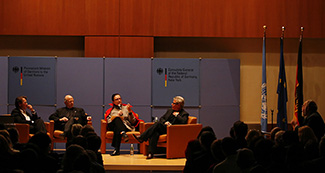
Berlin—New York Dialogues Urban Design and Memorials Panel Discussion at the German Consulate
© 2007, Chris Lee
Panelists from left: HG Merz, Lance J. Brown, Susan Szenasy, Daniel Libeskind
German Consulate Partner Events ›
But both ideas figured in the rich event, broken into several intros, presentations by Libeskind and HG Merz, who’s created several museum and memorial spaces in Germany, and a lively panel discussion that added Lance J. Brown, a professor at CUNY, and Susan Szenasy, editor of Metropolis magazine.
Rick Bell, executive director of the AIA New York chapter/Center for Architecture, which organized the event, kicked off the evening with images of memorials from Germany and New York, starting with Track 17 at the former train station in the Grünewald section of Berlin, nothing more than small plaques laid into the train platform. The photo showed one reading “11.9.1942/104 Juden/Berlin Theresienstadt.”
The track is lined with such plaques, listing how many Jews were deported on what date and to which camp. I remember seeing this small memorial in Berlin and imagining what groups of that size would look like, especially moving down the lush streets of Grünewald. And I shuddered at the crimes that had taken place where I was standing. The memorial is effective because resists attracting attention, as Musil suggests, in favor of letting the viewer do the thinking and remembering.
Oh, I could go on all day about this topic, but there’s no room! So here are some highlights. (For great writing on these issues, see the work of James E. Young.)
Moderator Ron Schiffman, an urban planner with the Pratt Institute Graduate Center for Planning and the Environment, discussed the challenges of integrating memorials into the urban fabric and finding suitable scale for them, while other panelists seemed more concerned with preserving authenticity and evoking emotion in a memorial. There was talk of celebrating not just death and victimhood but also life with memorials and of the difficulty of creating, as Libeskind said, “a story that is also spatial.”
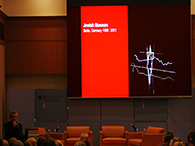
Daniel Libeskind speaking at the Berlin—New York Dialogues Urban Design and Memorials Panel Discussion at the German Consulate
© 2007, Chris Lee
German Consulate Partner Events ›
Libeskind presented his familiar Jewish Museum in Berlin, WTC project, and other works. Then Merz presented several projects, including his recent work on the Sachsenhausen concentration camp site just 30 kilometers outside Berlin. He began with aerial photos of its original sunburst-shaped design, heralded at the time as the “ideal camp,” because it could be controlled by one machine gun.
Most disturbing about his presentation were photos of the surrounding neighborhoods of one-family houses with yards and trees. The camp itself was torn down in 1945–1952 by the occupying Russians, who turned it into a park, leaving the remains of just a few original buildings: two bunkers and the space called “Station Z,” Z meaning the end, where execution techniques were researched.
Merz’s charge was to create a memorial out of the camp-turned-park. He chose to cover the existing remains of Station Z with a low translucent ceiling and keep sources of information minimal and unobtrusive.
This is what the panelists meant by authentic: Merz could have built a big, dare I say American-style, monument or information center, but instead he let the actual remnants of the events (or crimes) speak for themselves.
Brown said there’s “nothing more powerful” than actual items, which “emanate” energy and stories.
Later, panelists and audience members described their favorite memorials, most of which work either or a small scale or with authentic objects, and there was a lot of talk about how New York will move forward with the WTC site.
Shiffman, who mentioned several times the “remarkable social cohesion” that overtook New York after 9/11, said he was “heartbroken” by the “missing authenticity” of the WTC site.
Brown’s last words of the evening were a recommendation to engage with the memorial sites we pass every day and use them to start dialogues about what happened there and what’s happening today.
Berlin as the Anti-New York
11/05/2007 02:54 PM
Posted by Kris Wilton
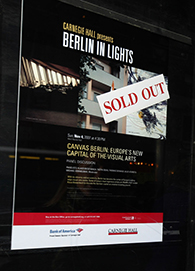
Canvas Berlin: Europe’s New Capital of the Visual Arts Panel Discussion
© 2007, Chris Lee
There was something dissatisfying about the Canvas Berlin: Europe’s New Capital of the Visual Arts panel discussion, which a woman I met in the lobby called “arid and antiseptic.” Maybe, but I’m not sure that’s it.
The panel was a great bunch—artists Tacita Dean, Thomas Demand, and Julie Mehretu, along with Kunstwerke and MoMA curator Klaus Biesenbach, and with New York Times critic Michael Kimmelman moderating.
I think the discomfort arose from this: The very things that the artists on the panel praised about Berlin Kimmelman repeatedly criticized.
The artists all spoke about the cheap and plentiful space to live and work in. Dean said she suddenly found herself with “a good standard of living” after coming to Berlin on a DAAD grant seven-plus years ago (she stayed), and Mehretu praised “the space for life,” meaning time for leisure and family and all-day brunches. They discussed the freedom that living in an economically depressed city affords; Dean especially seems liberated by the lack of overpowering arts institutions such as the Tate in her native England.
Kimmelman said he recently decided to take a break from New York and live in Berlin, which he was attracted to “because it’s constantly in a state of becoming, not being.” He went on, however, to criticize the state of Berlin’s art institutions, which he called “horrible.” He said there’s “no sense of curatorial creativity” coming out of Berlin and that the city’s “an incubator for artists, but only up to a point,” with few opportunities for exhibition and no infrastructure. He also said that there’s no sense that the Berlin of today represents any ideals, as Weimar Berlin did.
Dean countered that the period’s ideals may not crystallize into something visible until later.
Everyone agreed that Berlin’s particular freedom results from what Kimmelman called the “absence of commerce.” Because the city’s economy is in trouble, few business concerns are moving there, and the sorts of people who do are creative types. Because the institutional art scene is weak, there’s little social hierarchy and no exclusionary practices, like you find in New York; people of all sorts are welcome at openings, etc., and there’s a lot of mingling among creatives. Demand said you can round up a good dinner party or roster of artists with a few text messages, where in New York you’d have to send out invitations six months in advance.
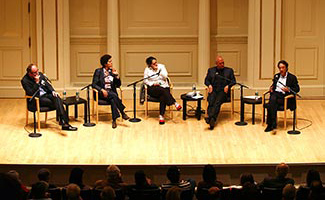
Canvas Berlin: Europe’s New Capital of the Visual Arts
Panel Discussion in Weill ›
© 2007, Chris Lee
Panelists from Left: Thomas Demand, Julie Mehretu, Tacita Dean, Klaus Biesenbach, Michael Kimmelman (moderator)
Everyone praised the amount of free time, calling Berlin the anti-New York or the anti-London. Demand said that to afford even a halfway desirable space in New York you have to work so long and hard that you never get to use it for what it’s intended for. (Hear hear!)
I think what may have been going on here was that while the panelists were happy to discuss why Berlin’s such a great place to work, Kimmelman was trying to stick to the panel’s aim: discussing Berlin as “Europe’s new capital of the visual arts.”
Berlin doesn’t have New York’s institutions and galleries, but the artists here at least (and probably the thousands of less established ones who really make the scene there) seem to find that more a pro than a con.
Biesenbach said that the city’s art galleries are actually booming, but that a total unknown can still set up an exhibition in an empty storefront and tons of people will show up. Kimmelman attributed this to the “lower temperature” and the stakes being completely different. Well, yeah. Exactly.
Follow the Free Money
11/05/2007 09:04 AM
Posted by Nick Romeo
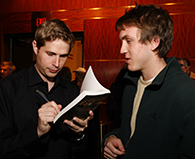
Daniel Kehlmann with Berlin in Lights blogger Nick Romeo
© 2007, Chris Lee
American novelist Jeffrey Eugenides first moved to Berlin because he was evicted. His wife had just had a baby and their Brooklyn landlord found a particularly cruel law that actually made a baby grounds for eviction. His sudden homelessness happened to coincide with the news that he’d won a grant in Germany that offered him a free apartment in Berlin for a year. So he went, in his words, “the way of all writers, following the free money.”
He told this anecdote during a panel at Carnegie’s Weill Recital Hall titled Berlin Stories: Literary Journeys Through the City. The rather broad theme of the panel allowed the discussion to roam through such diverse topics as the terrible quality of German translations of Nabokov, the geography of memory, and the role a government plays in nourishing a culture of reading.
The discussion began with the moderator, editor Michael Naumann, asking the four novelists to explain their connection with Berlin. The connections ranged from the tenuous to the intimate. On the weaker end of the spectrum was American Nicole Krauss, who had spent only three months in Berlin. At the other extreme was German writer Peter Schneider, who has spent the past four decades writing essays and novels about Germany and Berlin, his home. Yet despite their different involvements with the city, the panelists all seemed to agree that Berlin has a thriving artistic culture to which New York pales in comparison.
Eugenides’s eviction underscored a larger truth about New York City: it’s a very expensive center of world finance that tends to value commerce more than aesthetics. Berlin, by contrast, is a city of cheap rents and generous government subsidies for the arts. After Eugenides mentioned his free apartment in Berlin, the Austrian novelist Daniel Kehlmann joked that he would be happy to accept a free apartment in Manhattan for a year. If only the grant existed that would give him one.
Naumann also emphasized the stark contrast between the number of independent book stores in Germany—where a fixed price for books protects small booksellers—and the corporate bookstore culture of America.
Important as this was, I found the panel most interesting when discussion of government support of literature gave way to discussion of literature itself. Krauss made the interesting observation that her novel The History of Love and the city of Berlin share an approach to memory. Her novel is “about characters who have suffered something, and relied on the power of invention to make the past bearable. I imagine that Berlin has also had to re-imagine its history to be able to endure it.”

Berlin Stories: Literary Journeys through the City
Panel Discussion in Weill ›
© 2007, Chris Lee
Panelists from Left: Peter Schneider, Daniel Kehlmann, Nicole Krauss, Jeffrey Eugenides, Michael Naumann (moderator)
The power of 20th-century German history was strong enough that Daniel Kehlmann, whose novel Measuring the World is set in the late 18th century, still felt that his book was about later atrocities. “In writing about the beauty and humaneness of German classicism,” he said, “you can’t avoid the fact that this beautiful worldview couldn’t avert the horror of what happened later.”
The conversation itself couldn’t avoid the subjects of political memory and recrimination. The last portion of the panel consisted of an exchange about the validity of the recent trend in German discourse to perceive Germany as a victim in World War II. During this part of the discussion, the two American novelists sat quietly while the Germans debated heatedly.
The entire panel reminded me of a line from the Czech novelist Milan Kundera’s The Book of Laughter and Forgetting: “The struggle of man against power is the struggle of memory against forgetting.” German literature since World War II has embodied this struggle. Though the process has been slow, memory seems to have gradually triumphed. Bernhard Schlink’s novel The Reader and Günter Grass’s memoir Peeling the Onion are just two of many books that confront the painful past of Germany. And a topic that was once so totally taboo and inflammatory can now be considered with relative candor and civility. Daniel Kehlmann put it best when he described the feeling of the younger generation in Germany: “a lot of the old fire and the old anger have left these discussions.”
A Long and Winding Road:
Today’s Architects Take on Berlin’s Robert Moses
11/04/2007 11:56 PM
Posted by Kris Wilton
The first indication we were in for a long night at the Berlin architecture panel discussion was the occasional comment from moderator Barry Bergdoll that the panelists would be discussing a point “at length over the course of the evening.” Heh? Course of the evening?
The stage was set for a panel discussion, but instead we got five presentations, each about 30 minutes long: one by Bergdoll on the history of Berlin architecture and four in which architects presented current or past work. I could try now to summarize what they discussed, but I couldn’t do them justice in this space or with this brain, which I learned tonight knows less about architecture than I thought.
Ultimately, this event reflected a larger challenge of the festival: determining who the audience is and how best to serve it. At the end of two and a half hours of presentations, when I’d estimate that about 40 percent of the audience had left and the rest of us were disappointed that we’d never even gotten to the discussion part of the evening, Bergdoll thanked the die-hards for staying, saying we all must be architects or architecture fanatics.
I don’t know—were we? The sea of blocky designer glasses suggested we were, but who is the festival really for?
In truth, the material presented tonight—the projects, the concerns—was enough for an entire symposium of its own. For architects. A lay audience of Berlinophiles, however, needed more background and less material overall for this Sunday-evening event. There was simply too much to process.
Especially lacking was a clear delineation of the issues facing Berlin now. What I gathered over the course of the evening were the following dilemmas: How do you balance rebuilding, reconstruction, and renovation—should architecture push Berlin into the future or honor the past? When it comes to preservation, how do you deal with structures that by today’s standards are frankly ugly, as Louise Hutton has had to do in her firm’s update of the GSW building? If you’re conserving or refurbishing a structure, as David Chipperfield is on the Museum Island, how do you repair damage—in this case from bombing, fire, and 60 years of water damage—without introducing something now anachronistic and inauthentic? Do you restore structures to their original (outdated) glory, or, as Chipperfield has done, reconnect what can be saved with new, unobtrusive fabric?
Jan Kleihues and Hutton spoke about preserving neighborhoods’ character and scale while working creatively within the guidelines established by Hans Stimmann, the city’s building director from 1990 until 2005. The panelists uniformly derided Stimmann, but at the end of the evening I still wasn’t sure what exactly what their beef was. Bergdoll called him the Robert Moses of post-unification Berlin, so I get the gist, but a primer about what exactly today’s architects were up against would have been helpful.
The last speaker of the evening was Jürgen Mayer H. (gotta wonder what that H. stands for), who presented three projects, none of which were in Berlin. His firm is based there, and I imagine he’s tried to build there, but this presentation was frankly frustrating. Whatever he was supposed to bring to a panel discussion about Berlin architecture was lost without the discussion.
As gratifying as it was to engage with the panelists’ projects, particularly Chippenfield’s painstaking, excellent work on Museum Island, which a neighbor of mine called “absolutely extraordinary,” I think the evening could have used less presentation and more discussion.
Bergdoll said at least one of the panelists was reluctant to discuss the city’s architectural future, since it’s such a great unknown. But he recommended the Berlin–New York Dialogues exhibition at the Center for Architecture, which is part of the festival, for those who’d like to explore the issue further.
A City of Malicious Energies
11/04/2007 05:36 PM
Posted by Nick Romeo
Long before it was a Zankel Hall, the basement theater at Carnegie Hall was a movie house that for years screened a steady stream of foreign, classic, and avant-garde films. On Saturday night the space became a cinema once again to show a film that was all three—foreign, classic, and, despite its 1927 release date, still edgy and avant-garde. The movie was Walther Ruttmann’s Berlin: Symphony of a City, and it was accompanied by a live performance of composer Edmund Meisel’s score.
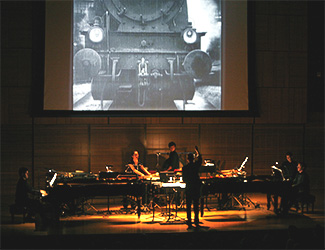
Berlin: Symphony of a City in Zankel ›
© 2007, Jennifer Taylor
Ruttmann’s and Meisel’s Berlin-Symphony ›
Ruttmann’s film contains little of the lyricism its title suggests. A more strictly accurate name might have been something like “Berlin: Sinister Cacophony of a City.” And while this may be a slight exaggeration—the movie does have lyric moments and droll interludes—the overwhelming impression was of a grimly mechanized city fraught with a deep unease. The first shots we see are of a train traveling into Berlin. To say that trains are a motif in the film would be a gross understatement. There are shots of trains moving and stationary, shots of trains from the front and from the side, from near and far, and even shots from the perspective of a train. The music during the opening sequence was foreboding, all tritones and tremolos, and something awful seemed imminent. But then the music dropped to silence and the camera showed shots of deserted, early morning streets. The city gradually became populated with human figures, first a man posting handbills, then a few more people, and soon the screen was swarming with masses. The music registered this awakening with gradual crescendos and steadily increasing harmonic tension. Soon the constant propulsive rhythm from the percussionists began to predominate in the score, and industrial images flashed across the screen. In fairly quick succession we see a full range of the energy of industry; there were shots of levers, cranks, pistons, steam, flames, cranes, smokestacks, and factories.
This is a far cry from the newly industrialized world of Chaplin’s Modern Times. The factory in Ruttmann’s vision is not merely a new realm for antics and playfulness; it is a sinister character in its own right, imbued with cold rhythmic life by the tension of Meisel’s score. Ruttmann’s interest in the mechanical also seemed to inform his shots of humans. When the camera showed only the legs of a crowd, all the preceding industrial imagery made the legs seem almost automated, pumping pistons, just one more manifestation of the same locomotive energy that is the film’s obsession.
Ruttmann’s film made masterly use of suggestive conflations. There were shots of crowds followed by shots of cows; a savage fight between two dogs was followed by a heated argument between two men. There were moments of brief relief from the violence of the imagery and manic tension of the score, but they never lasted for long. If the film had a climax, it came when a woman jumped off a bridge into a river. Before she jumps we see a close-up for her face, one of very few in the movie, and her bulging eyes and mad gaze were followed by a shot of the river closing over her. The repeated images of humans crammed into trains and the conflations of humans and animals made it difficult not to see the film as a prescient anticipation of the mass deportations of Jews on cattle cars that were just a few years away. Yet despite these unsettling qualities, the audience left the former movie hall abuzz with talk and opinion, fueled by the film’s demonic rhythmic energy and eager to discuss its dark vision.
Going Back
11/04/2007 02:19 PM
Posted by Noah Block-Harley
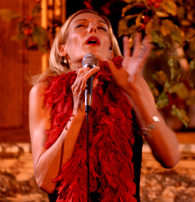
Ute Lemper at Neue Galerie’s Café Sabarsky
© 2007, Stefan Cohen
“We’re going back,” Ute Lemper began last night in her deep, smoky voice, “to the year 1927.” “Going back” seemed to be both the theme and goal of last night; Lemper was to repeat the same line several times before the end of the night, in each instance evoking a sexier, less sober, yet dangerous and melancholy point in time. Fittingly, the dimly lit Café Sabarsky at the Neue Galerie—with its Josef Hoffmann sconces and Otto Wagner fabrics—played host to Lemper, the latter one of the foremost interpreters of the Weimar cabaret era and a sight to behold even without the music. She may have been svelte and she may have been polished, but Lemper commanded the stage and sang with the gravity of someone who has both years of practice performing within a tradition and a seriousness of purpose born of that practice.
Prowling around the tiny stage, flirting with the timid, and seducing the hapless, Lemper succeeded not only in drawing laughter and enthusiastic applause from an otherwise tame audience, but also in giving us (yours truly included), a brief glimpse into what Weimar Berlin might actually have felt like. Much of what is enviable in Ute Lemper’s performance consists in the fact that her voice is as accomplished as her delivery; the former switching from a deep, melancholy croon to a cynical sneer at the drop of a hat. Weimar cabaret is not “pretty” music by any stretch of the imagination, and Lemper played the part of dubious ringmaster with aplomb. Her dry wit and her licentious remarks to the crowd accompanied perfectly the grotesque and often unnerving descriptions of pirates, whores, and murderers that characterize the genre. Swaying back and forth silently to the eerie oompah of the piano, when she finally sings “asking me kill them now or later / and I said now,” one is brought to the scene of the murder itself.
It was not only her performance that impressed, however; Lemper interspersed throughout her performance histories of the men and women responsible for the music, as well as the dazzling but ill-fated history of cabaret in Berlin. In Lemper’s hands the story of cabaret becomes as much about the persecution of the art form (many of whose main representatives were of Jewish origin) as it does the brilliance of the work; in the end it becomes impossible to separate the two. “There is a lot of Sehnsucht in [Weill’s] songs,” Lemper notes in an interview, “and what I really like about it [is] that the romanticism is always interrupted, broken, with aggressiveness, and it never gets sentimental.” Perhaps unwittingly (she herself remains in voluntary exile, splitting her time between Paris and New York), Lemper hints in this quote at a tension within her own work that was on prominent display last night. In a performance that attempts to bring back Weimar Berlin for a New York audience 90 years later, there is a fine line between re-creating the past and romanticizing it. This tension holds true generally for the entire conversation surrounding the “cabaret revival” Berlin is currently undergoing; it seems disingenuous to choose and celebrate a remarkable part of one period’s culture without acknowledging the close relationship it holds to remarkably troubled and unsure times. Lemper’s real triumph consists not only in representing all that was admirable in Weimar, then, but also in communicating the dark times of which it was a product.
A Well-Oiled Machine
11/04/2007 09:12 AM
Posted by Kris Wilton
The first thing I thought when I saw the setup for Berlin: Symphony of a City was that the two grand pianos pushed nose to nose reminded me of Mies van der Rohe’s Neue Nationalgalerie in Berlin: Especially in the serene, wood-paneled Zankel Hall, the low, long, black bar they formed seemed to embody modernity.
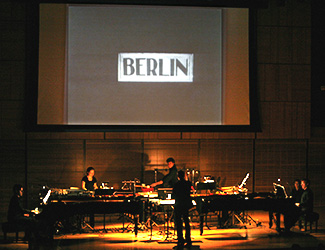
Berlin: Symphony of a City in Zankel ›
© 2007, Jennifer Taylor
Ruttmann’s and Meisel’s Berlin-Symphony ›
Weird, I thought. I’d seen the film several years ago in Berlin, and it felt strange to show such an old film—a silent one! from 1927! with a score performed live!—in such a modern setting. But I was completely wrong.
Walther Ruttmann’s Berlin: Die Sinfonie der Grosstadt is a celebration of modernity, a rejoicing of technology and industry, and a glowing example of Neue Sachlichkeit, or New Objectivity, the post-Expressionist aesthetic movement that I’d only ever associated with visual art.
Depicting a day in the life of Berlin, the film, divided into five acts, is essentially all form, no content. No real story is told. There are no characters. There are only innumerable shots of Berlin waking up, going to work, and going about its daily life.
The majority depict Germany’s interwar productivity and abundance, with the trains that open the film setting the tone and pace. There are also streetcars and early automobiles, still cavorting with horse-drawn carriages. There are Fordian production lines and mass-produced goods like milk bottles and light bulbs. There are busy telephone switchboards and weird automated things in shop windows and giant logos in lights.
My second response to the setting was that the quartet directed by Helmut Imig overpowered the rather small screen. I’m still on the fence about this. The screen appears small in part because of its outmoded aspect ratio (CinemaScope wouldn’t be developed until decades later), though I also imagine the original 1927 screen would be dwarfed by the multiplex proportions we’re used to today. But the premiere featured a 75-piece orchestra (!), not two pianos and two percussionists, as this one did, so I’m guessing the sound was supposed to overpower.
I can’t speak to the original score, which was noted for its quarter- and atonality, but the paring down to this arrangement seems to make sense. The pianos and other keyboard instruments (glockenspiels, etc.) provide bouncy melodies while the various percussion instruments often illustrate the visual: splashy cymbals bring locomotive steam to life, for example, and I don’t know what they used for the meat-hacking scene in a butcher shop, but it seemed Foley-real to me.
The score and film were intended as a Gesamtkunstwerk, with the footage, gathered over the course of a year, carefully edited to fit the forward-driving rhythm of the score, for which Meisel spent hours listening to the sounds of the city, particularly of the factories.
Of course those factories are long gone now, along with the horse-drawn carriages and slaughterhouses and milkmen and evening papers. But Berlinophiles will recognize a lot of infrastructure and architecture.
The film ends with a lot of shots of a roller coaster that a film student I met at the festival and who grew up in East Berlin told me is still in Treptower Park. This imagery, along with repeated visual crescendos that often end with abstract, spinning motifs, suggests, well, a whirlwind of a city, a place that can’t be captured because it’s moving and changing too fast. That spinning came to a halt not long after Die Sinfonie der Grosstadt, but it’s back now.
Tarantino Meets Fassbinder,
Herzog Does the UWS
11/04/2007 08:20 AM
Posted by Kris Wilton
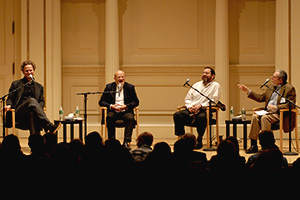
Screening Berlin: Filmmakers’ Views of the City
Panel Discussion in Weill ›
© 2007, Stefan Cohen
Panelists from left: Florian Henckel von Donnersmarck, Volker Schlöndorff, Michael Barker, David Denby (moderator)
Last night’s “Screening Berlin: Filmmakers’ Views of the City” panel discussion was not the first time Best Foreign Film Oscar winners Florian Henckel von Donnersmarck and Volker Schlöndorff have met, though I think that might have been news to Schlöndorff.
FHvD, the Lives of Others wunderkind, said that as an aspiring filmmaker with no connections, he drafted a long letter to Schlöndorff, “the biggest guy in the business,” at the UFA studio at Babelsberg, where he had become chief exec after the fall of the wall, and requested a meeting to discuss “important strategic decisions’ for his “nonexistent career.”
Schlöndorff met FHvD there in his office, where the Tin Drum director says, “Everything was pure 1927 revised by Socialist refurbishing,” and promptly advised him to forget Germany and go to Hollywood. (Schlöndorff’s response to the tale? “I don’t remember a thing.”)
It’s ironic, because after making a German film about German issues that he insists was nothing of the sort, FHvD has just made that move to Hollywood, with his wife and three kids.
Rounding out the panel were Sony Picture Classics co-founder, co-president, and godsend Michael Barker, who’s brought to America such manna from heaven as Crouching Tiger, Hidden Dragon and, well, a whole lot of Almodovar.
New Yorker film critic David Denby, a stern and likable moderator, posed several rhetorical questions to prompt the discussion: What is German cinema? What’s being made, and with what financing? Can you have a filmmaking center in a city that is not a business or financial center but rather a political and artistic center? What’s the dynamic between remembering (Germany’s cross to bear) and our all-too-human tendency to forget?
There followed lots of talk about:- Cultural exchange: Barker called German influence on American filmmaking “incalculable,” and said there’d be no Tarantino without Fassbinder, and no Alias without Run, Lola, Run. Schlöndorff countered that American culture has pervaded Germany since the American occupation of Germany after WWII, which he called “very different from the one in Iraq.”
- The historical importance of New York to German filmmakers: Schlöndorff said that during the ’70s and ’80s, Germans, seeking a cultural center and finding none, took their films to New York. Werner Herzog, he said, “thinks of the Upper West Side as his audience.” To which Denby replied: “There’s a Herzog cult at Zabar’s.”
- International resistance to foreign film: FHvD discussed how the English trailer for The Lives of Others featured no dialogue at all (Denby attributed this to a global association of the German language with Nazis; Barker said it’s not unusual for foreign film trailers). FHvD also explained Run, Lola, Run’s small French turnout by saying that the dubbed version foolishly changed all the street names to French ones and all the German marks to francs. Barker said Run, Lola, Run was “a revelation” in the US, however, because its great success showed that young audiences have no problem with subtitles.
A highlight of the evening was FHvD’s explanation of how he made The Lives of Others look so drab and East German. He said he learned from a color specialist that a lot of new colors were developed in the ’60s and ’70s, mostly in the US. East Germany didn’t get those patents, of course, so the tints there—for clothing, cars, etc.—stayed the same while the rest of the industrialized world got brighter. To replicate this in his film, he used no reds and blues in the costumes, sets, or props, a technique that apparently worked; he said former East Germans always comment on the aesthetic’s authenticity.
And biggest laugh of the night came from Schlöndorff, in response to an audience question about why films by Dani Levy—a Swiss Jew who reintroduced Jewish humor to Germany—haven’t done well here. After a bunch of musing about the difficulty of translating idioms, etc., Schlöndorff set the full house roaring by simply explaining: “The last thing you need to import to New York is Jewish jokes from Germany.”
Glitz, Glamour, and Hickory-Smoked Kettle Chips—
New York Meets Berlin
11/03/2007 04:32 PM
Posted by Noah Block-Harley
Ah, the Guggenheim. Where sitting is strictly verboten (as your humble scribe had the misfortune to discover last night), and standing still generally frowned upon. While Arts after Dark at the Guggenheim may have been attended largely by rote—most had no idea who exactly the DJ was, for example, and many came because “a friend had told them to come”—the Guggenheim managed last night (as it usually does) to attract a hoard of the well-heeled and the eccentric. Among the cast of characters:
- Three men wearing fake moustaches and aviator sunglasses who admitted, after intense interrogation, to being there solely “in order to chat with 22-year-old women”
- A chain-smoking British art dealer who hissed a long, if inventive, string of expletives when asked about the music and proceeded to perform a 15-minute autopsy of the New York art scene.
- A man overheard asking one of the guards: “D’ya suppose my wife and I could sit on the exhibit for a second? It’s just that we are making Christmas cards and …”
- The man himself: a modestly bespectacled Alexander Barck (one-sixth of the Jazzanova sextet), flanked by an ensemble of black-clad Berliners
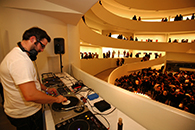
First Fridays at the Guggenheim
© 2007, Chris Lee
At its worst, the night resembled a ritzy junior-high school dance; glamour girls flitted about the exhibit while the boys pretended to check their watches and reached for the Lays (or in this case, hickory-smoked Kettle Chips). No amount of glitz, however, seemed to faze Barck—a tremendously important character in the nu-jazz scene in Berlin who may be used to such a crowd—who paused regularly for pictures and the occasional head bob. His set worked well with both the space-age setting in which he was playing and the well-curated if sprawling Richard Prince exhibit. The video installation set up by Toby Cornish of Jutoju—another Berlin-based collective which has designed much of Jazzanova’s cover art—was evocative of the Berlin I for one have come to know and love: gray building developments against a grayer sky; the hum of the U-Bahn and the crowds around Alexanderplatz. The (albeit) small bit of Berlin brought to the Guggenheim last night more than compensated for the see-and-be-seen attitude also in attendance at the event, even though I did have to pass up the Third Annual Carnivorous Nights Taxidermy Contest to attend. Really.
All in all, if Berlin in Lights is not only a celebration of Berlin but also a staged encounter between New York and Berlin, Art after Dark was a great kick-off event for the festival, pairing an institution which is eminently “New York” with two collectives representative of a certain type of performance-art coming out of Berlin. A young lawyer who had lived in Berlin for several years after the wall came down sighed when asked what he thought about the two cities: “It’s not that I prefer one to the other. It is that I am stuck always wishing that the one were the other.”
I’m off to the Ute Lemper performance later this evening, and don’t forget about Berlin: Symphony of a City tonight at 7.30!
Is This Man Funny, or Is He Just German?
11/03/2007 03:59 PM
Posted by Nick Romeo
Vocalist Max Raabe seems to have the peculiar ability to transform any performance venue into an elegant German dance club circa 1932. His concert at Carnegie Hall last night was no exception. The audience members became sophisticated socialites, their coughs sounded like the clinking of champagne glasses, and the seduction of a minor countess seemed to hover in the near future. Raabe achieved this bewitching effect only partly through his music. His specialty is the music of Weimar Germany, and while he did the obligatory Kurt Weill and Franz Lehár songs, his musical nostalgia ignored nationality and embraced songs by Irving Berlin and Cole Porter. And while the tunes were charming, the lyrics clever, and the band excellent, Raabe couldn’t have had the transporting power he did without, well, himself. He began each song with his legs crossed and his elbow resting on the lid of the piano. After the brass band played the introduction of the tune, he strolled seductively toward the microphone as if about to kiss it. He postured and posed and always managed to strike the perfect balance between the debonair and the debauched. Part of the humor of his act was the delicious contrast between the cheesiness of the music, with its weeping vibratos and schmaltzy melodies, and the utter poise and elegance of Raabe’s delivery. He sings couplets like “of all the girls I’ve known and I’ve known some / until I met you I was lonesome” with a deadpan delivery that nicely underscores their goofiness. He also likes to introduce his sets with a mock aphorism like this: “music has always been closely tied to destiny and personal tragedy” … beat … “who cares?” The lines were often less inherently funny than exceptionally well delivered, and it certainly didn’t hurt that he had a German accent and pronounced big band as “bik bant.” At one point he merely uttered the words “Greta Garbo” and the audience burst into laughter.
It’s a bit odd to feel nostalgia for a time before you were born and a place you’ve never lived. Yet as the evening wore on I found myself longing wistfully for my days as a German sophisticate, drinking champagne and mispronouncing “Greta Garbo. “ The rest of the audience seemed to share my feelings; they swayed with the melodies and tapped with the oompah beat of the tuba. Though Raabe’s charisma and the band’s gimmicks could have camouflaged sloppy musicianship, they only enhanced an already excellent ensemble. Raabe’s voice is virtuostic in its versatility; he slips sweetly into a high falsetto only to belt into a big band sound a moment later. He does elegant patter, dreamy croon, and sweet falsetto with equal grace and ease. A vocal rendition of Fritz Kreisler’s “Liebesleid” was a miracle of pianissimo gentleness and pathos. The band, or the Palast Orchester, as they’re grandiosely dubbed, was excellent. They too had their share of choreographed antics, which included a hand-bell routine where different band members played different notes of the melody, each standing for his note then sitting down again. They reminded me of a more talented version of the local barbershop quartet who simultaneously pull kazoos from their back pockets and play the melody two octaves too high.
Near the end of the performance I couldn’t help thinking of an exhibit at the Met last year titled “Glitter and Doom.” It presented paintings from the Weimar period that were haunting in their blending of elegant decadence and grotesque corruption. Max Raabe certainly captured the glitter of those years, but I craved some of the doom.
An Acid-Free, Water-Resistant Introduction to Berlin in Lights
10/30/2007 08:59 AM
Posted by Noah Block-Harley
Greetings, and welcome to the Berlin in Lights festival blog! Myself, Noah Block-Harley, along with two other Berlinophiles (Nick Romeo and Kris Wilton) will be posting regularly throughout the festival with reviews, listings, thoughts on the current arts scene in Berlin, and the occasional rant (what would a blog on Berlin be without some controversy, after all). Before I offer any thoughts on the program, however, some sort of introduction seems apt. My own interest in Berlin comes mostly from my experience working and living in the city; once as a bumbling, semi-fluent coordinator for a poetry festival, and then as—of all things—a newspaper delivery boy. Forgive me, the pay was so good, so regular. My interest also comes from a long-standing fascination with the city’s history; few other cities can lay claim to such an illustrious and notorious past as Berlin. From its role in the German nationalist project to the brief-lived glory days of the Weimar Republic, from the nightmare of the Third Reich’s tenure to the divided city’s epitomization of Cold War politics, Berlin and its residents have both benefited and suffered from their role on the political world stage in a way few other cities have.
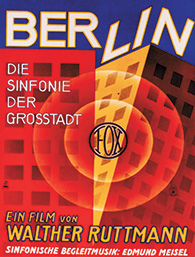
Berlin: Symphony of a City Poster
Sat, Nov 3 at 5 PM in Zankel Hall ›
Sat, Nov 3 at 7:30 PM in Zankel Hall ›
No other city, for that matter, fits more exactly Comrade Marx’s dictum that the “weight of the past hangs like a nightmare on the brains of the living.” Berlin still bears openly the scars of much of its history (Richard Holbrooke’s excellent article), and Carnegie Hall is right to emphasize in their program —through the cabaret performances and film screenings, about which more later—the close continuity between Berlin’s historical arts-scene and its more recent counterpart. Carnegie Hall is also right to recognize and celebrate Berlin now, while Klaus Wowereit’s (known affectionately to Berliners as “Wowi”) by now infamous proclamation that Berlin is “poor but sexy” still applies. Berlin remains a tremendously exciting place on multiple fronts for all walks of life; the techno-junkies, the classical crowd, and (last and proud of it) the immaculately hip have all managed to co-exist (at the time of publication) peacefully. While no two-week festival could aspire to present a complete picture of Berlin in all its beauty, squalor, and weirdness, the festival program offers a remarkably wide and promising variety of events, one of which I want to highlight in closing: Berlin: Symphony of a City (on Saturday, November 3 at 5 pm and 7.30 pm in Zankel Hall). The film offers a brilliantly shot look at Berlin in the late 20s along with a great score by Edmund Meisel. The piece presents a great introduction to a city which no longer exists visibly today (the Berlin of Weimar Germany), but which nonetheless serves as an important reference point for a lot of artistic work coming out of Berlin today.
When I first traveled to Berlin in 2004 I bought a copy of Lonely Planet’s guide to Berlin (I know, I know). “So you’ve decided to go to Berlin,” the, acid-free, water-resistant introduction began. “Good idea.” The same applies here: you’ve decided to attend Berlin in Lights. Good idea.
Berlin’s Still Sexy
10/29/2007 10:32 PM
Posted by Kris Wilton
Before there was New York, there was Berlin. For me, anyway. Though I started visiting New York in the ‘90s from Pennsylvania, where I grew up, I inhabited Berlin first, from 2000 to 2002, a very good time to live there. Now I live and work in New York and visit Berlin. As often as I can.

Berlin Wall
Berlin was the first city I really considered as a city—its architecture, urban design, development, gentrification. It was hard not to. When I first moved there, the sky was full of cranes: Train stations, office towers, urban centers were all being built or refurbished. Entire neighborhoods, like Prenzlauer Berg and Kreuzberg, where I lived, were undergoing radical transformations. Remnants and repercussions of World War II were being discovered and discussed every day: Warheads were found at construction sites, memoirs were unearthed, new damages were brought to light. And Berlin, in the process of becoming the German capitol, was searching for its place in it all. The potential—for change, for expression, for creation—was electric.
Though both Berlin and New York can boast significant metamorphoses in the past couple of decades, and both draw creative and curious minds from all over the globe, to me Berlin is the more dynamic metropolis right now. Since the fall of the Wall in 1989 the city has undergone unparalleled financial, cultural, political, socioeconomic, and demographic upheaval. The former East was absorbed into the West (or vice versa). The geographical center(s) of the city shifted. East Berlin staples disappeared, then reappeared years later as Ostalgie—from Ost (“East”) and Nostalgie (“nostalgia”)—for all things East German took hold.
Because Berlin was two parallel-running cities for so long—from 1961, when the wall was built, until die Wende (“the change”) in 1989—it now has the distinction, and some of the financial burden, of bearing at least two of most sorts of cultural institutions. There’s the Staatsoper (German State Opera) in the former East and the Deutsche Oper in the former West (not to mention the Komische Oper). There are two zoos, five or six major symphony orchestras, more than 50 theaters, more than 150 museums, a crackling nightlife, and countless artists, musicians, actors, writers, filmmakers, and dancers taking advantage of it all—and the cheap rents. Like affable mayor Klaus Wowereit said, “Berlin ist arm, aber sexy” (“Berlin is poor, but sexy”).
This year, Berlin is coming to me in the form of the Berlin in Lights festival. I won’t make it to every event, but you can bet I’ll be hitting as many as possible. I can’t wait.
Ignorance is Power
10/29/2007 10:58 AM
Posted by Nick Romeo
If nothing else, four years at an expensive college taught me that admitting total ignorance of a subject can be a very useful skill. I find it particularly helpful around physicists and other devotees of the hard sciences. Not only does a confession of ignorance absolve me of any responsibility to contribute something meaningful to the conversation, it also tends to increase the likelihood that I’ll learn something interesting. Many people feel about classical music the way I feel about physics; they’re intimidated by technical details, rarified jargon, and maybe still recovering from a traumatic exposure by a well-meaning relative. But despite their professions of total ignorance, most people are perfectly willing to learn more aabout a new subject if it is presented in an accessible way. The beautiful thing about music is that “knowledge” is essentially peripheral to experience and enjoyment. Knowledge can enhance one’s enjoyment, but it’s certainly not a prerequisite.
While I may claim ignorance of physics, my knowledge of gravity is implicit in every movement I make. And while many may claim ignorance of classical music, they have a similarly intuitive knowledge of its joy. Given the scope of the upcoming Berlin in Lights Festival, it seems nearly impossible not to be ignorant about some or even most aspects of the festival. This is precisely its strength. In a way, the festival is a microcosm of the ideal of a liberal arts education: a bunch of absurdly knowledgeable people sharing ideas to the mutual benefit of everyone involved. If you know nothing about German cinema, there’s The New Yorker’s David Denby moderating a panel discussion. If you know nothing about the German Cabaret scene, there’s Ute Lemper performing at the Neue Galerie. Whatever your métier, your particular patch of expertise, the festival is so broadly conceived as to make learning something new almost inevitable.
Enchantment with the cultural riches of Berlin has a long tradition. I was recently reading the memoirs of the Polish pianist Arthur Rubinstein when I stumbled on this quote: “The artistic and cultural life of the metropolis [Berlin] around 1900, was of the highest order… What a wonderful unforgettable life of music opened up to me!” A brilliant pianist, Rubinstein also soaked up performances of plays by Shakespeare and Ibsen, attended the opera, and followed the career of the young Max Reinhardt. Whatever else has changed in the centuries since Rubinstein was a teenager in Berlin, the city retains an abundance of musical and cultural riches. We can all, like Rubinstein, learn something beyond our particular realm of expertise. In the Apology, Socrates declares himself the wisest man in Athens precisely because of his clear understanding of the limits of his knowledge. Unlike almost everyone else, he admits his own ignorance. If only we could all know so little.
© 2001–2007 Carnegie Hall Corporation








